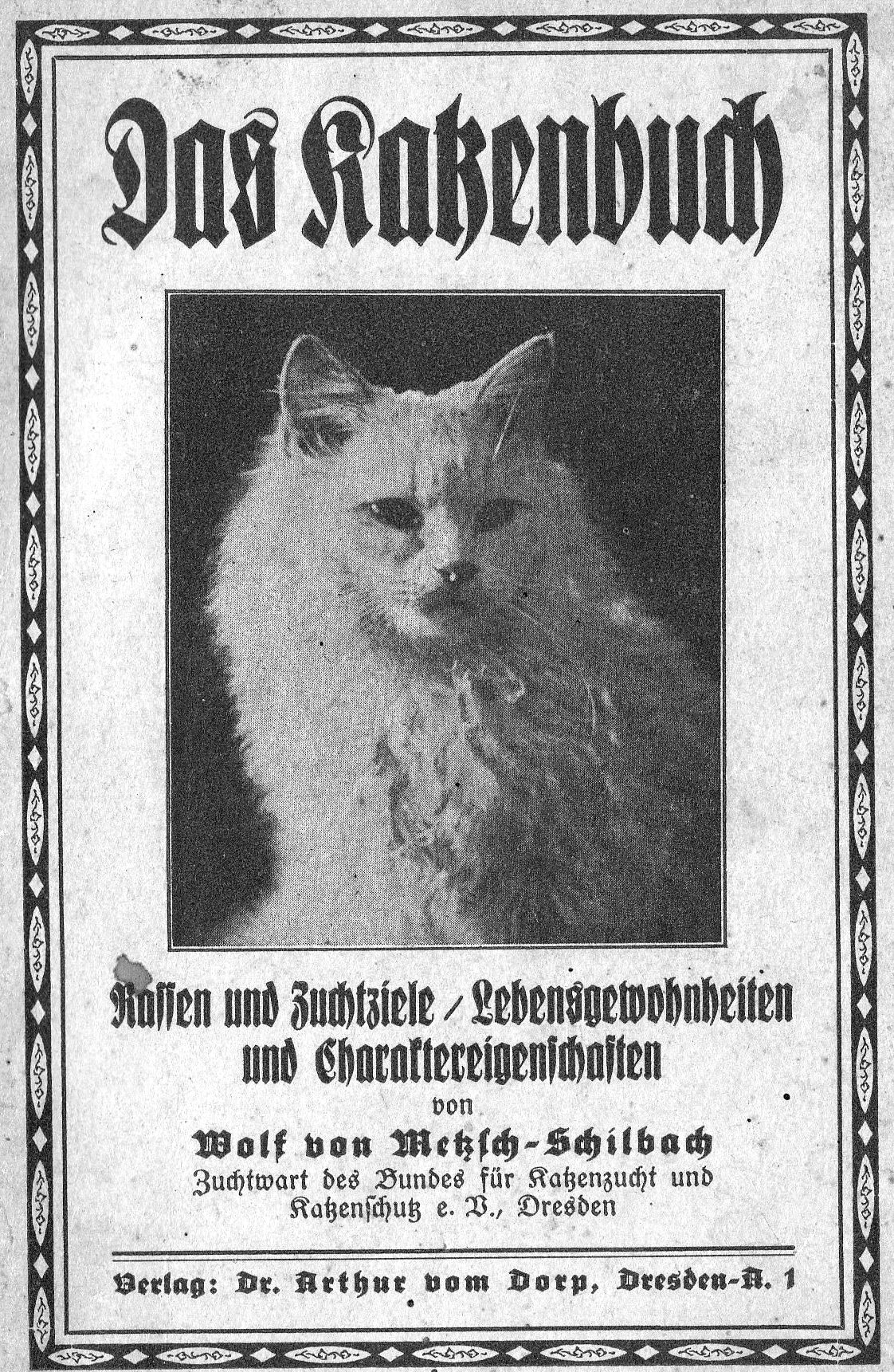
THE BOOK OF CATS
Breeds and Breeding, Behaviour and Characteristics
by Wolf von Metzsch-Schilbach
Breeder of the Federation for Cat Breeding and Cat Protection e. B., Dresden
Publisher: Dr. Arthur from the Dorp, Dresden-A.1

CONTENTS
A Review of the Cat
Cat Lovers
The Cat and Islam
The Cat as a House-Pet
Ancestry of Pedigree Cats and Tabby Cats [lit: Cyprus Cats]
Views and Breeding Possibilities
Black-headed Cat [Moor-headed Cat]
Masked Cat
Three-coloured Cats
Self-Coloured Cats
Siamese Palace or Royal Cat
Angora and Persian cat
Carthusian cat
Chinese cat
Different Breeds with Insufficiently Established Characteristics (Stump-tailed Cats)
Cats Farms
Construction of a Cat Farm
Usefulness of the Cat
A REVIEW OF THE CAT
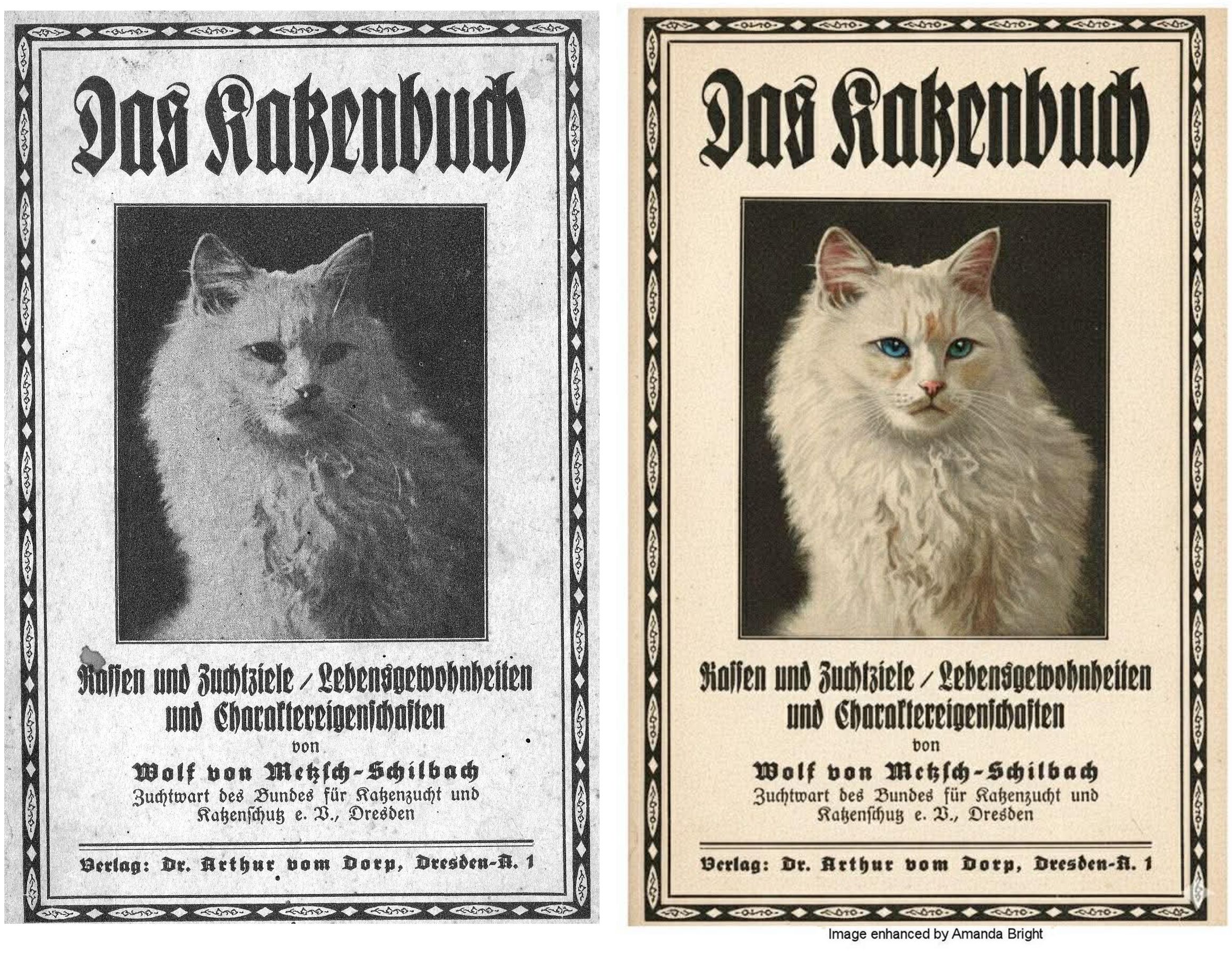
While selection has created an overwhelming number of breeds of the canine race, the cat is free. Each individual domestic cat can be considered as a racial creature, it represents a fixed type, which has proven to have remained unchanged for thousands of years. There are, however, some especial pure breeds, but as a whole they are hardly significant, for there are not many breeds, nor are there a great number of cats belonging to any particular breed. Even the more widespread Angora cat is a very rare phenomenon. Thus accidental mixing, which plays such a great role in the canine race, and thus adversely influences the overall picture, is almost absent cats. The cat, due to its behaviour and its much freer lifestyle, is tougher, and more natural than the dog; it has preserved itself as a magnificently natural creature, it has not been stunted, it has hardly been softened, and has not degenerated in the least. She arranges her own breeding, if you can call it that, to an almost completely "unwritten page," and whoever wants to write a "cat book" cannot make it easy, as so often happens, by using examples from twelve older ones to create a thirteenth. A really trustworthy breeder, really a consultant, cannot be written yet. We are, after all, entering new territory. Even with regard to the few races which have actually assumed firm form, we do not know how they arose in Far East Asia many centuries ago.
Therefore, for the time being we only have guidelines for breeding purposes. But in order to strive for them with success, it is time to portray the cat as it is without prejudice. For none of our other house is the following so true:
"Confused by the parties' hatred and favor,
Her character varies throughout history."
If it seems to be an omission that in Europe, and especially in Germany, that little attention was given to the breeding of cats, there is, on the other hand, an explanation for this peculiar phenomenon. The majority of pet breeders are motivated to create animals which are useful and fulfil a special purpose. There is no such motive when it comes to cats. Though in her own territory she is, like the dog, a hunter, in contrast to the dog she "makes her own way as a free daughter of nature." Moreover, the game that she chases is such that man is not interested in catching. Their nightly prey, whether it is confined to small game such as mice, or to the larger game such as rats, is undertaken on their own account and their own risk. It is their "wild impulse" that leads them into temptation, sometimes even the smallest winged game, and this makes them many enemies, but this can be combated by means other than breeding that is by training. It is easy to raise well-manner cats that consider birds as "Noli-me-tangere" [not to be touched]. But it is also not difficult for the less obedient cat to fall into this unauthorized branch of hunting.
Anyone who has lived in the country knows that the small cat always gives the large rooster a wide berth, because he once earned her respect with his beak. Now, experience has taught that a cat never again bothers small songbirds after experiencing one or, at most, two unpleasant experiences. With the aid of the very first sparrow, which is easy to procure, and a dead one will suffice, one only needs to "peck" the nose and the face of the cat, and we shall soon observe that from that hour the cat shuns even the most harmless bird. It seems to us that a similar experience explains why cats that are otherwise mouse-hunters, but do not dare hunt rats, look back on a similar unpleasant experience with a vicious rat and it has made a deep impression on them. (*Footnote)
(Footnote: We are told by a fellow scientist from Coburg that the well-known deceased ornithologist Dr. Baldamus also greatly recommended this procedure, which he had reliably tested. Brehm possessed a young lioness, who had already grown out of the childhood and had the beautiful name Bachita, German for "the lucky one." She lived in an improvised travelling menagerie in Khartoum, and was allowed to roam freely and live with him in an intimate relationship, just like a domestic cat, albeit much larger. Like all animals she knew how to get respect, especially of large people, but she did not harm anyone. Everyone was afraid of her so she was the young queen of the small animal park. And now Brehm tells the little episode, which is reproduced here, to illuminate the royal big cat s respect for a bird's beak. Brehm says: "My animal society was enlarged by the acquisition of a Marabou stork. At the moment this formidable bird was attacked by the lioness. For a long time, Bachita had been lurking, playing with her tail in a catlike way, rising up out of the ground and staring rigidly at the new arrival. Now she wanted to frighten him in the usual way, and when he approached sufficiently close she made a powerful leap at him. The bird, though it was startled and jumped into the air, did not hesitate for a moment, but boldly strode towards the amazed lioness with outstretched wings, and quickly drove her away with a series of emphatic blows from his enormous, wedge-shaped beak, convincing her that no victory could be won without fighting. The lioness, suffering from disgrace, fell upon the bird, which was already prepared for new attacks. But the Marabu, with extraordinary rapidity and safety, gave such an abundant number of blows that Bachita withdrew from the flight. With blows from that beak, the victorious bird pursued its quarry into all corners and corners, so that the lioness only escaped to safety by climbing up the wall of a low building. She did not forget the lesson she had been taught. She left the stork in peace, and exerted her power only over the other animals as she done before." According to Brehm this happened in Khartoum in Sudan. From time to time we can see the same scenes in real life on every German farm between the housecat and the hens. We give this story only as an illustration to the doubters, who might think that the cat's fear of a bird's beak is in the realm of animal fables, not that of animal life.)
Otherwise it is futile hoping to count on the obedience of the cat. Even the most enthusiastic cat-lover will admit that she is only obedient in the same way as the huntsman s terrier, whose owner says is always obedient as long as is told sharply Either go or not! and then it either goes or not!
You will always be prejudiced against the cat and often arrive at false perceptions when, as is so often the case, you compare her to the dog. These animals are as different from each other as it is possible to imagine. We fully agree that the cat behaves differently to the dog; take her attentiveness and vigilance, for example. She is in fact very vigilant; she is aware of every sound, but she is entirely uninterested in any sound which, in her own opinion or experience, does not concern her personally.
When she is sleeping soundly, she always positions herself so that one of her ears remains free to pick up every sound. A crash on the stairs, which can make dogs furious, leaves cats completely unmoved, but the quiet scampering of mice can be detected from a distance of 14 meters, according to reliable observations, and she reacts as fast as lightning.
She knows her name just like the dog knows his, but she often reacts to it in an amused and amusing manner. Her face can look positively indifferent, even bored, and she simply looks to the left when she is called from the right. If the call is is more urgent and our little, especially clever, cat is aware that there is no longer any use in looking away, he begins to hunt an imaginary flea. "Iddi," an abbreviation of Viktor von Scheffel's classic cat "Hiddigeigei" is the name he hears, or, as the case may be, he chooses not to hear. But as soon as the name of his rival "Itze" is called, he will be there. Curiosity or jealousy has transformed his indifference into eager interest. Even if it is a matter of teaching a cat a trick, one should not allow oneself to be misled by the erroneous belief that she does not understand what is required of her. She merely does not understand what purpose it serves for her to play dead on command or to jump, just because some someone is rather inconveniently holding a stick right in front of her nose. Why am I being disturbed from my routine? she may be thinking, for she is not a zealous servant like the dog. One may well assume that only those cats which are very vain can be trained and are willing to be praised. There are cats who can tolerate at least as much applause as any theatre primadonna.
Undoubtedly there are also people whom cats obey very willingly, and those who do not care in the least. I know of a Russian who is always lucky be able to touch lions, tigers, and wild cats whom the guards don t like to get close to, and who my two cats always fell in love with when he entereds the room. He has never really tried to gain their favour. It is as if they suspect that he is a great friend of animals and an equally determined despiser of men. I say "suspect" for they cannot have understood that he once declared in their presence, in earnest and in jest, that human beings were nothing but degenerate monkeys. My cats cannot have understood this, because they do not speak a word of Russian. Through its internal convictions the cat is never obedient or subservient like the dog. A fine animal psychologist says: "The cat always remains half-wild, free from any subservience, she has preserved an inviolable freedom." They are nobility of free-born sex say their eulogists, and a poet (Henne) exclaims with emphasis:
On the roof in the open air,
I am a free cat."
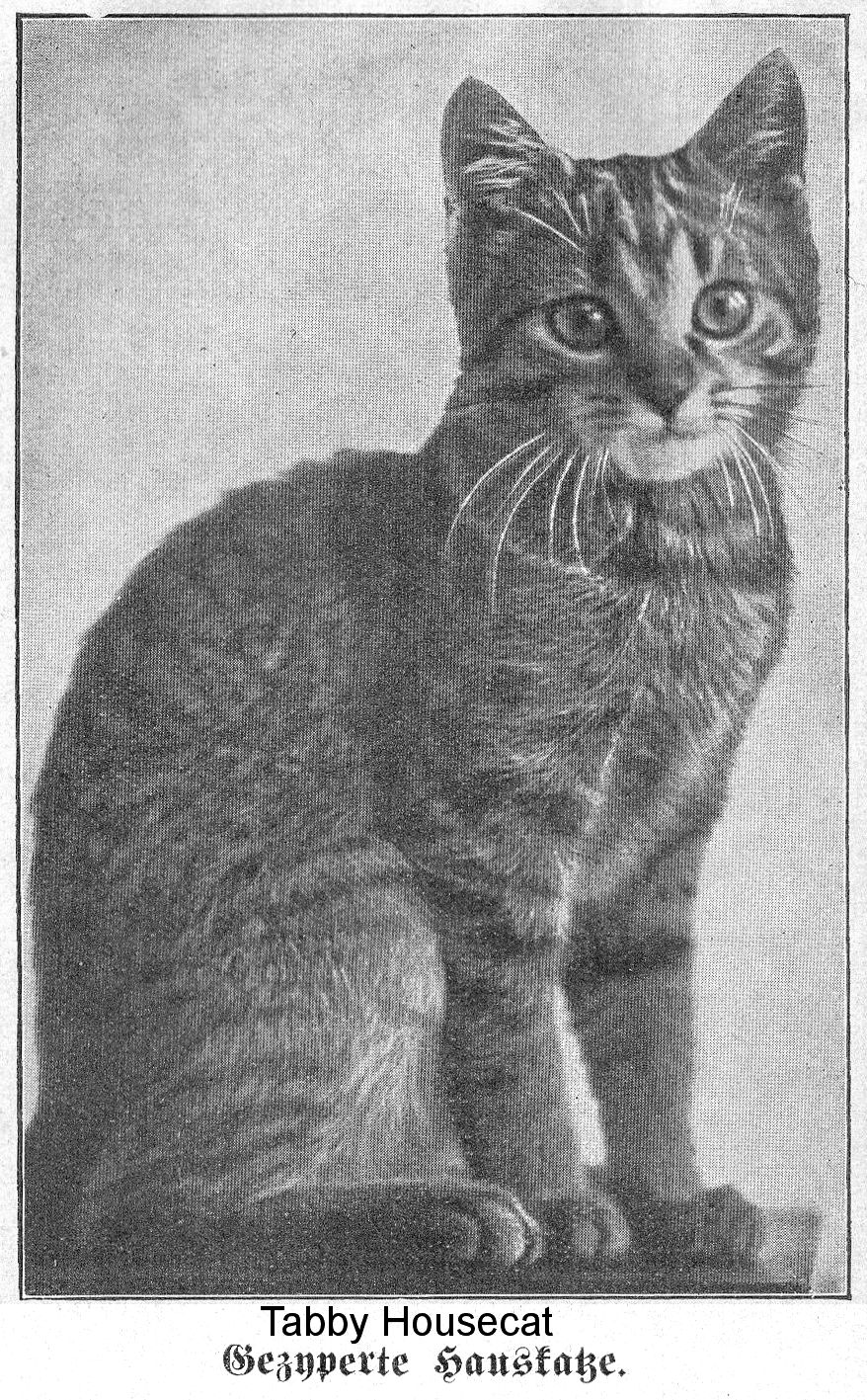
CAT LOVERS
A beautiful, white young maiden,
Sat in the house in sunshine
Her eyes were bright and clear,
As she licked and arranged her hair.
She kisses her hand to wash herself clean
Smoothing the hair of her delicate head
My heart is bursting with love
And I would like to do this for her.
We have the same noble manners
And I would ask in love and friendship
That I might kiss her snowy hands
So that all my worries would end.
Thus wrote Rottenhagen [Rollenhagen], in his teaching poem "Froschm useler" [The Battle of the Frogs and the Mice], regarding "Br seldieb" [the crown prince of the mouse kingdom] to give an impression given by the sight of his white kitten. Certainly it is rather delicate description, especially when we consider that it was written three and a half centuries ago, in rather rougher and coarser times. It is true that the "tender young lady" soon turns out to be a "false wench" and this must not be overlooked, not from the viewpoint of man, but from that of Br seldieb, the mouse. It is a brilliant thing fact that a mouse could find anything pleasant about a, much like a hare extolling the qualities of a hound, or a dove those of a hawk.
But wherever German literature or poetry concerned itself with the cat, a beautiful spirit, a profound grasping of this animal in nature, cannot be found anywhere. This is true of Tieck and Magnus Hoffmann, according to J.F.W. Zachari , whose hexameter "Wurrner in Hell," written more than 200 years ago, can hardly be judged poetic.
Among our writers on nature and animals, subtle Mafius found all sorts of friendly and clever words, but did not have much in his inner heart for this animal. L ns fails completely when we search through his works. Infinitely far above him, especially as an animal writer, but also in his profound understanding of nature, stands the Danish Svend Fleuron. His book, "Katzenvolk, a Family Chronicle," surpasses by a great distance [lit: by a number of horse-lengths] everything in the world that has ever been written about the cat. Of course, the real cat-dyed in the wool cat-hater should never hold of this book, all he will get from this magnificent book is how the environment punishes such a feral cat family, as it is masterfully portrayed. He will never be able to grasp the profound tragedy of animal life as it is laid out here, an animal which sees its greatest enemy in man, but which is magically drawn to the society of men through a force bred into its blood over the generations. What French writers and almost all the modern ones are obvious cat lovers - say about our pet is, on the other hand, vapid, witty, sometimes charming, sometimes affectionately superficial and frequently just foolish.
Quite incomparably warmer, more understanding, loving, oriental peoples have grasped the nature of the cat. We must mention them here, with the sole exception of the Jews, who, were unquestionably well acquainted with cats before their expulsion from Egypt, and who knew quite well of the high, even indulgent honours cats enjoyed in the Land of the Nile. To them, though she was not quite so directly an unclean animal like the pig, she was nevertheless not an animal that was formally mentioned. There are no words of appreciation for her, though there are also none of contempt, found in the Bible, which otherwise has so much to say about the animal kingdom. Only the Jewish Rabi, Johanaan, who was one of the greatest religious investigators in the earliest post-Testament period, leans towards praise in his eulogy: "If the law were not given unto the sons of Israel, we would have learned culture and manners from the cat."
But all the other peoples of the Orient, especially the Mohammedans, are enthusiastic cat lovers. Not only to the west of the Red Sea, that is to say, in the African Nile region, do the ancestors of our domestic cats live wild, the African Wildcat can also be found spreading eastward into Asia, in Arabia, Palestine, and up to Persia. For, quite irrelevantly, we consider the age-old question of whether the Asians themselves domesticated the cat after the Nile-dwellers, or whether they obtained cats from the Africans. Due to canonization in Africa, cats ran into a dead-end and breeds did not develop further, so it simply got bogged down. She first made her career in Asia. In any case, it was the Orientals who have the honour of creating from this house-pet two distinct and unquestionably high-quality races, the Angora and the Siamese.
We Europeans, however, were unconsciously blind to their breeding until 1926. The movement which has just begun is therefore very welcome.
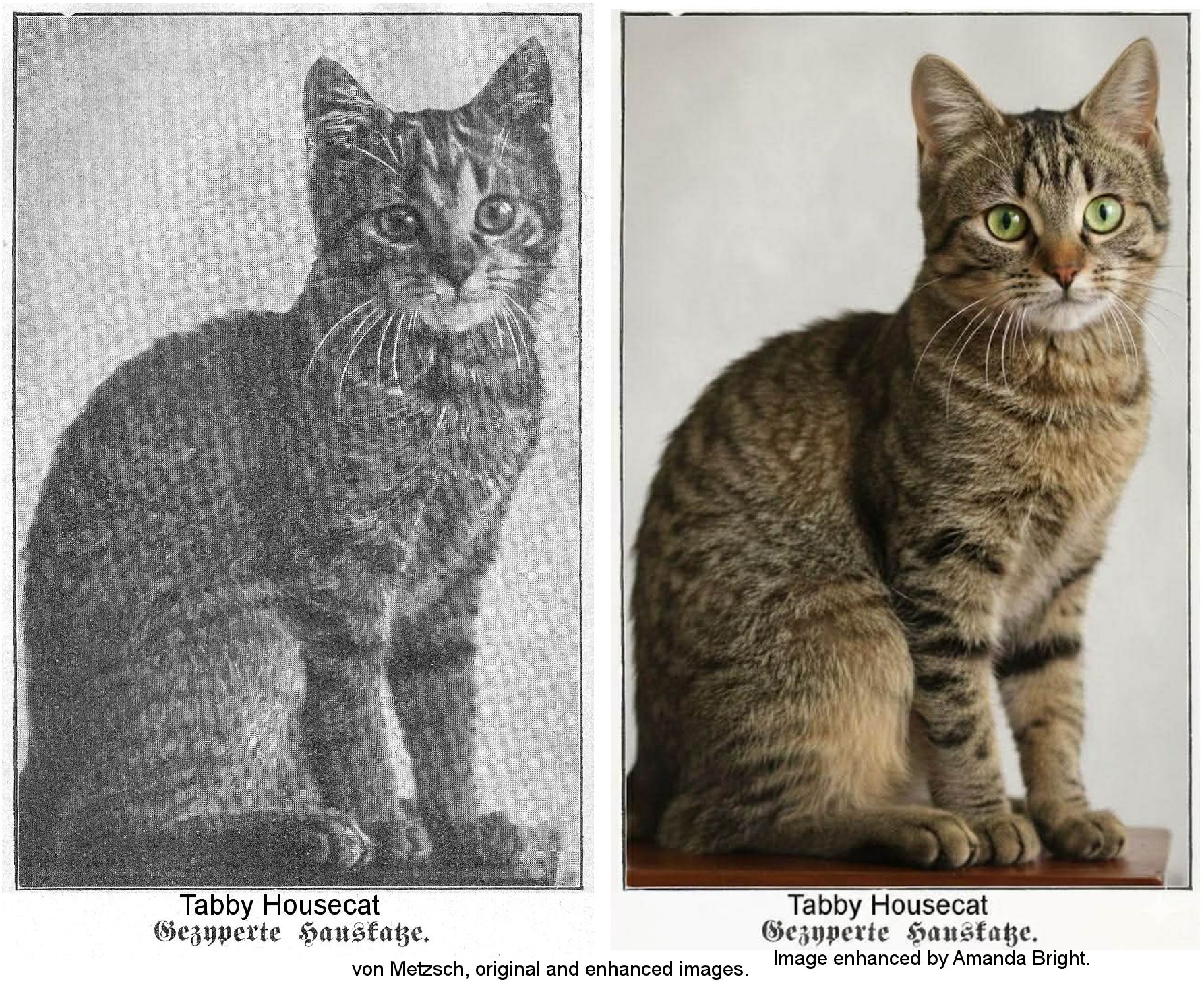
THE CAT AND ISLAM
The cat was not declared sacred in Asia, as it was by the Egyptian Pharaohs on the advice of provisions administrators and clever priests, but in conscious appreciation of its great merits, Mohammed placed them in the protection of all the faithful. In the Khoran there is a commandment to honour the cats. The Prophet also made sure that every Muslim, just like he himself, Allah s rulemaker, made for this creature, for what he thought and did was simply the will of God. Therefore the cat s particularly intimate and familiar relationship to the founder of this religion should not be regarded as simply a pretty tradition if its relation to the founder of religion, but as a conscious, high appreciation of the animal.
Once again, turmoil arose, as they did through much of the Hejira, the flight of the Prophet from Medina to Mecca, and followers anxiously pressed into the tent of the Prophet. But he slept, and beside him Fatme, his favorite cat, slept on the edge of his cloak. When the prophet was awakened, he quickly reached for his sword, cut off the piece of the mantle on which his little cat was resting, and only then did the messenger of God get up.
So goes the tradition. For every Muslim, however, it signifies infinitely more than just a pious legend, for they recognize the commandment to "go and do likewise." In all the mosques the cats were protected, often by a mullah, often a sheikh, with the honorary name "father" (abu), who likes to call himself the "protector of the cats. It is true that all rulers from the Mohammedan dynasty held the tradition of being the protector of animals, and even in distant East Asian courts, in Tehran, and Bangkok, cats found loving care and were reared with more understanding. Shah Nasr ed Dins was known in Europe for his splendid Persian tomcat "Vabr Khan," who shared every meal with his master, and elsewhere we have found occasion to discuss the gem of all cats, the Royal Siamese or Palace cat; which is similarly esteemed in court households and is linked with religious views, as it once was in the land of the Nile.
One really needs to see the deep contempt for the dog which is the reverse side of these cat-lovers. None of the everyday verbal clashes between argumentative Orientals is without the phrases: "You son of a dog," "Granddaughters and great-grandchildren of a bitch." There is no quarrel that does not end with phrases like these or with even more drastic insults!
Where Islam spread the half-moon banner of the Prophet, it also brought the cat with it as a domestic animal. In every harem, she was the pampered child, and she seemed created for the dreamy senses and the sweet idleness of those most closed-to-the-world prisons that human imagination has ever devised. We will conclude this point with some of Rollenhagen s verses reflecting on these considerations.
"They like to be with the women,
And to adorn their gowns,
As if they were their peers,
And sdhared their honour. "
THE CAT AS A HOUSE-PET
Less in the country than in the cities, the cat has really become a house-mate. From being a domestic animal it has formally developed into a pet, an accessory to the lap dog. Now, in particular, in the age of housing deprivation, it is necessary to take a close look, before one voluntarily lodges in a home without the urging of a housing authority, especially lodgings in a house "with use of the kitchen" and the cat is always in question. What is the information now? Cats are "false," or even "treacherous," they are notoriously "self-willed" and boundlessly "nosy." If the cat really embodies all these bad attributes we are right in asking if reasonable people would put up with such a monster in their surroundings if it wasn t actually necessary.
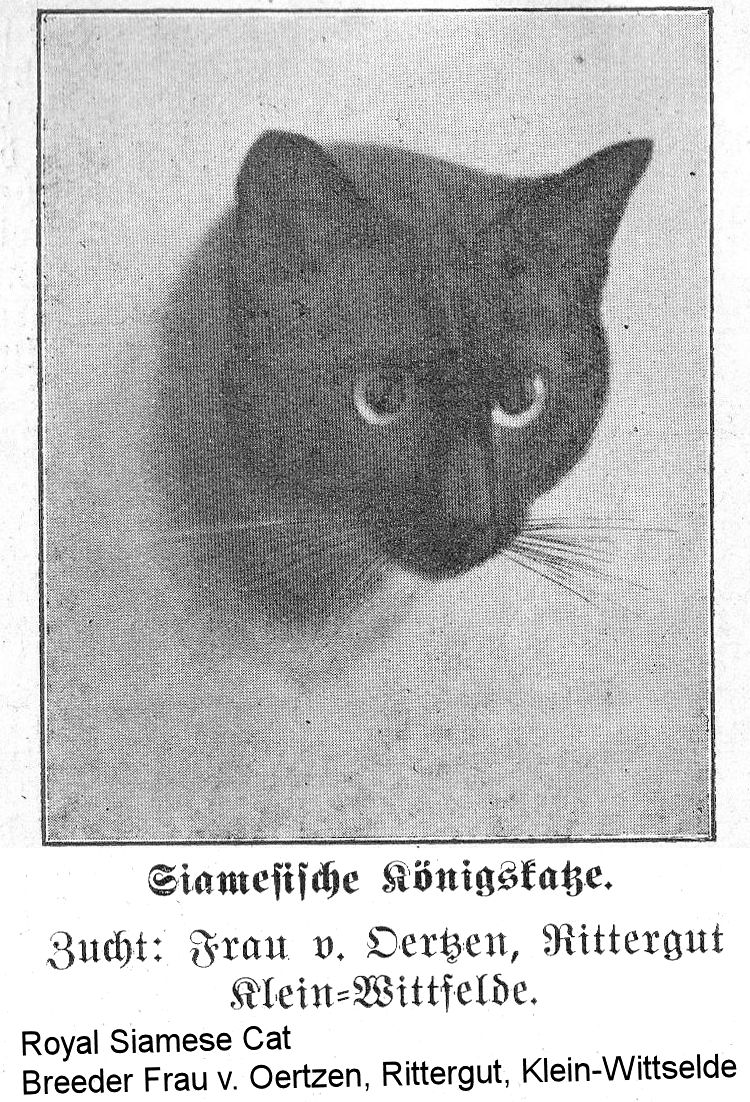
Since the cat, as the fine expression indicates, "is not yet taxed," there are no reliable statistics on how many millions of cats are kept around Germany; but the number is certainly a few million. Would really four times as many millions of people (if we count a family as comprising four persons) be so foolish as to suffer a creature that is dispensable in the vast majority of cases, if it has so many unpleasant qualities?
As with any bad reputation, there is ultimately a grain of truth in all the unfriendly things that are said of cats. We have already mentioned their very limited obedience. Cats may be false and cunning if that is how they ve been treated by false and treacherous people. The cat has a character; she does not have a slave's soul. She does not take kicks as her due, and if she is continually irritated, she will hiss loudly, and can bravely defend herself with her sharply equipped "velvet paws" whose claws are usually so gently and softly withdrawn, although she generally prefers to run from unpleasant encounters in a cloud of dust. It is true that from time to time we find aggressive indivuals among cats, but among all domestic animals, yes including their human masters, there are natural criminals. Everyone knows the means to get rid of them.
So, in terms of character defects, we are only left with disobedient and nosy, and these two things are, admittedly, much milder accusations, which, moreover, are quite often exhibited in such amusingly na ve and winsome ways that we cannot be seriously angry with the little sinner.
As to their nosiness, a well-known housewife assured me that her two kittens were far less guilty of this than her two housemaids (as servants are now to be called) since they were more often out of the house and less often giving a helping hand.
Finally, it must surely be considered pedantic, if you wanted to put yourself in the realm of true German Schoolmasterliness, to raise cats, of all creatures, to blind obedience, when its character is so completely independent. I would almost say that a placidly obedient cat would be an indifferent, dull creature. Her free subordination is far more valuable when it is given to someone she considers worthy of such favours. There is "Itze" the kitten. It gives a perfect image of comfort and cosiness, with its spinning-wheel purr, its snug and amiable shape.
How forcefully, and yet unobtrusively, she to invite the mistress to sit down so that she can climb into her favourite resting place, her mistress s lap. The term "Fluffy kitten" is rightly a phrase in common parlance, but it is never associated with the idea of falsity that description is attached to the flatterer. And with such a love of cleanliness, almost every kitten is restless, thoroughly washing and smoothing its soft fur over and over until it is perfectly groomed. The moistened fore-paws groom the parts which it cannot reach with its tongue, and that is why it seems so fond of scratching at its throat because, despite its otherwise great dexterity, it can only groom that area with the hind-paws and is unable to moisten them first.
He who speaks of a "Cat's Wash" as an an insufficient lick and polish, is a miserably bad observer. In every languages there are such false phrases that we could collect.
How appetizing she eats, it is not a mere matter of eating when she gently and delicately skims the cream from the milk, and she never greedily swallows hot porridge like dogs do, but cautiously walks around it it until it has cooled down. If her food is not to her liking she has the expression of an offended royalty, but after an enjoyable meal, she settles down and licks her lips with her little pink tongue, never forgetting, if she has had to use her paws even once, to clean them in the same way. How expressive is the indignant paw-shaking when a cat touches a liquid which it finds too cold, it gives the highest expression of animal refinement but, at the same time, it remains a pure unadulterated predator. "Idi," the otherwise well-behaved tomcat has grabbed a large and momentarily unguarded sausage. Quick as a flash he has disappeared with his prey deep in the balcony alcove behind a curtain. Only the threatening growling as he consumes his stolen feast, betrays his misdeed. Seriously, the little fellow seems to imagine that his growling would frighten anyone who wanted to take his prey from him. Who would be so humourless as to be furious at the little robber, and how dumb is the Finnish proverb: "Whoever loves the cat knows no other animal.
The meal is now over and is followed, like clockwork, by an extensive lunch nap on Aunt Anna's beautifully embroidered and equally vulgar sofa cushion, on which is stitched that old lie Just quarter of an hour." No, "Idi" is resting a full twelve quarter hours, almost embarrassingly accurate against the clock for his siesta. It is not until late in the afternoon, almost into the evening, that he will be speaking again. A little soft, round "something," rolled up like a pillow in hardly breathing snooze, this creature reminds us of our waking lion. His movements have a sinuous tension, he makes a purposeful and unerring leap along an accurately measured trajectory, and immediately after the jump, astonishingly, he walks among small, fragile figurines and a row of glasses, skilfully twisting between them and scarcely touching them with even his silky fur.
Although adult cats do not reach a great size, they are not insignificant, and there may well be a pressing question: "Is it desirable to breed cats, who are considered companions in a well-kept city home, to a certain stately greatness?" We believe the answer to this question should be"no"; delicate, slender shapes are certainly preferable. Puppies are also bred for delicacy and cats kept in the room or salon should correspond to the former in shape.
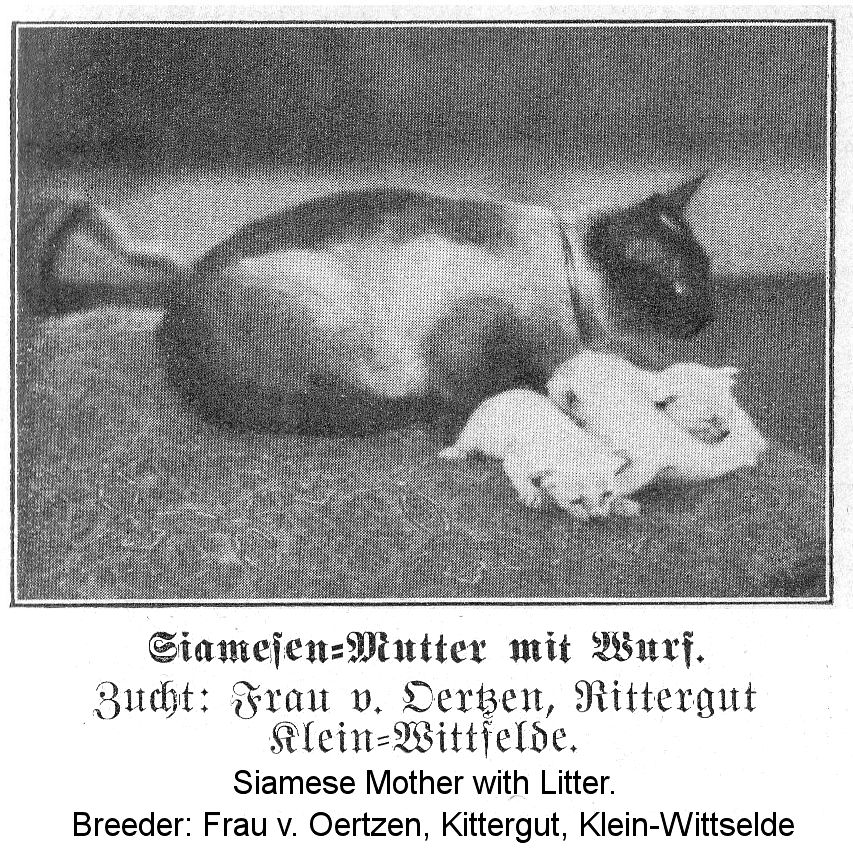
But let us return to its qualities. It is not easy to answer whether the cat is brave or cowardly. If she crosses the path of a dog that has been hostile to her she looks for salvation in flight, but if her path is blocked she defends herself bravely and as a rule, goes from a defensive position to an attacking one and very often bravely asserts the field, even against hunting dogs. Against smaller dogs, she often knows from the beginning that she can get their respect by hissing at them and that they dare not bother her. In most cases that the cat, unlike the dog, is "never the aggressor" and it will always be observed that when dogs and cats live together in a household, once they have become accustomed to one another, they not only tolerate one another, they become friends. A less common case, but one mentioned by Brehm mentions is that a cat might enjoy being carried around by a large dog in his mouth. All of their character contradictions are also expressed in their voices. The "meow," which we commonly think of as their main form of expression is a sound they don t actually make that often; as a rule it is usually only said with a mournful undertone when it feels hungry it it feels it is not getting attention. Much more often, she is observed to use short tones, which can best be rendered "Uf-uf," and which she can modify so well that it is easy to determine whether she is reproachful, express slight dissatisfaction, impatience, surprise of pleasure. And again, a contrast, in the spring-time mating season, cats can perform a concert so cacophonous that to Europeans, who are not used to such music, it sounds quite exotic. But to one who has lived in the tropics and who has heard the roaring and hissing of the big cats, from whose royal family our house-cat was born, the concert vividly reminds us of the original home and birthplace of the whole cat race. Indians speaks very vividly of the season of the loud voice."
Victor of Scheffel describes his cat "Hiddigeigei" on his nightly walks thus:
When the midnight storm is howling
In valleys low and mountains high,
Hiddigeigei climbs the chimneys
And roof-ridges to the spires.
Like a spirit, there he s standing,
More beautiful than e er before,
From his eyes fly sparks of fire,
Fire lights his bristling hair.
And he sings in wild fashion,
Sings his tomcat battle cry,
While far off the thunder s rolling,
And the storm roars through the night.
Never do people hear him,
Everyone sleeps in his house,
But deep in the building s basements
He s heard by the fear-filled mouse.
Well she recognises his voice,
And she is cowers, and she knows:
Terrible in his great fierceness
It is the old tomcat hero.
True, real, genuine cat music is far from that, rather it is just the prelude and it is not long before a whole singing choir is assembled, and then that love-crazed assemblage of cats perform a racket that is truly exotic. There is growling and hissing in all tonal grades, there is swearing and miauing, and in the ceremonial pauses a cat soprano responds and then all the hellish cat voices are immediately unleashed and, of course, singing solo is not the case. The cat cacophony does not mark the the end of the song, but merely the beginning of a new one.
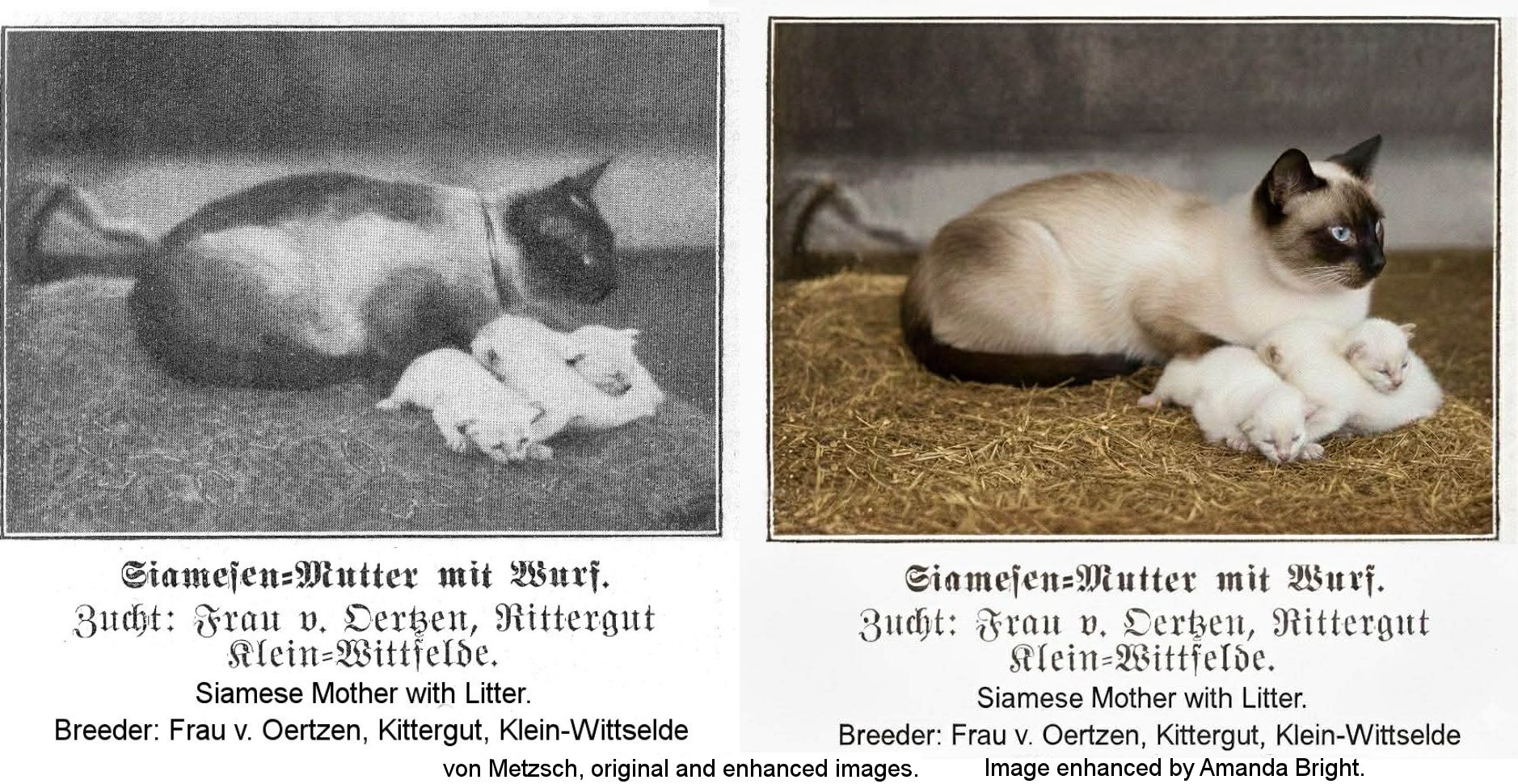
In his fables, Lich described the cat concert in a far less poetic manner than Scheffel, but in terms more realistic and correct. Since his account is often quoted, we would like to include it here:
Animals and people are soundly sleeping,
Even the household priest is silent,
When a crowd of guests come creeping,
And climbing to the eaves and ridges.
Above the rooms of the wealthy they ascended
Where these suitors sang such a song
To melt the stony heart of their intended,
All the while driving men mad.
Above Hinz, the Murners father-in-law,
They wailed their lamentation,
And two tomcats, much scarred by war,
Sang like tormented souls .
And then the horde of cats were howling,
Crashing about the roofs and screaming,
Hissing and wailing, scratching and howling,
Until the householder woke up.
He leapt from his bed, seizing his staff
Blundering around the dark hallway,
Striking the mirror, which fell with a crash,
Overturning a dozen bowls,
Then, stumbling over a pile of wood chips,
He knocks over the hall-way clock,
Breaking two rows of teeth as he slips;
He discovers that blind rage is painful!
The beast, who at night was able to make such gruesome noise, becomes a solemn, silent companion later on. This is why the cat is so unimpressive; it has such a great need for rest. She probably spends at least 16 out of 24 hours of the day, if not actually asleep, dozing, resting in comparative calm. Her need for rest goes hand in hand with a similar great need for warmth. This is an inheritance from their hot, sunny origins in the heart of Africa, in the dry steppes of Nubia. Perhaps their great fear of water is also related to this. As far as possible she keeps out of the way of the wet, and if she does get thoroughly rained on, she presents a pathetic sight and looks obviously unhappy. It is only after she has dried off before a warm stove that she starts to purr cosily and feels happy again.
Let us come to the conclusion of our admittedly weak attempt to impartially judge the light and dark sides of the cat s character, a conclusion that Johannes Trojan expresses quite amiably in a little poem sure to please all cat-lovers. [Johannes Trojan, 1837 1915, was a German writer whose works included children's verse and humorous poetry.]

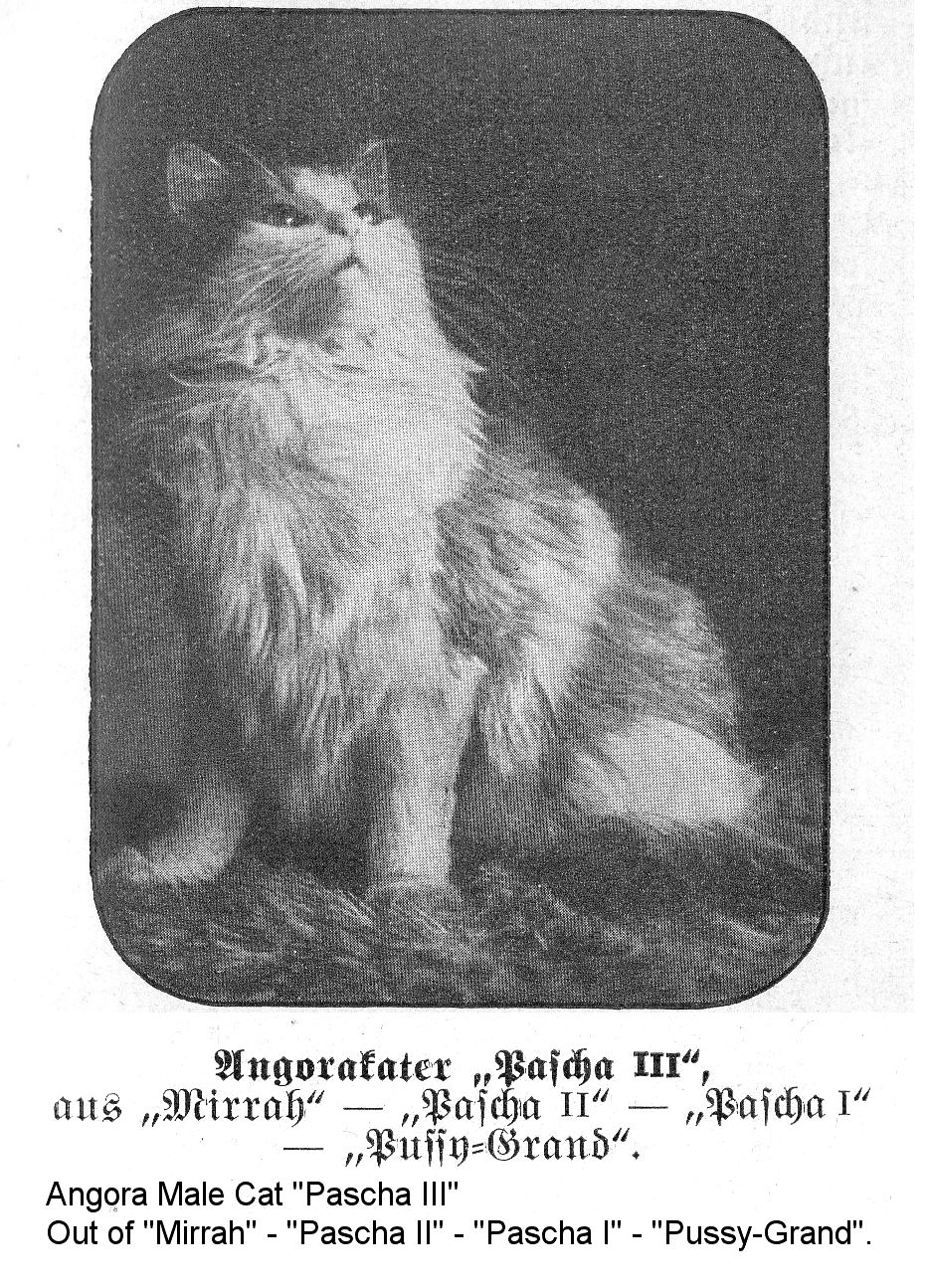
The Kitten At The Door
In a large city I found a grand house,
An elegant house in a grand town,
Reflecting great wealth, it had many floors.
But I greatly miss one thing,
An important something -
Something is missing in front of the door.
Out in the country, a small house I found,
With a small garden in bloom all around,
Blossoms and bushes and flowers and more.
And something else that I liked to see,
Something that is important to me -
There s a little cat sitting in front of the door.
If I should purchase a home fit for me,
Here are the things I would prefer to see
Modest and small it will be, for sure,
A swallow s nest in the eaves,
But the thing I most need
Is a little cat sitting in front of the door.

ANCESTRY OF PEDIGREE CATS AND TABBY CATS [LIT: CYPRUS CATS]
The long controversy over the ancestry of the cat was only completely clarified in the 1870s; Rippel discovered the ancestor in the form of the African Wildcat found in the Nubia, or, more precisely, the wild-living original form of our domestic cat. Schweinfurth, who penetrated deeper into that dark continent, met the people that had first made a pet of the cat. These are the Njam-Njam, whose spread reaches as far as the Nile. These Nubian people still live in round huts in village-like settlements, they eat untamed animals and also their domestic animals; as pets they only keep dogs and chickens, fattening and slaughtering these. In addition, they have were the first to gradually tame the African Wildcat and accustomed it to their homes where they were greatly plagued by mice. Certainly, the steppe-dweller was easily accustomed to this welcoming environment, because it was as easy to find there, as it was in the still undeveloped wilderness. It may have been a few thousand years from then until the cat came up Nubia and into Egypt. Here, among the legendary grain chambers, in this country of the proverbial plagues, there were certainly mice; the cats from the round huts became house-cats and even temple-cats. They were said to be sacred and their mummies are impeccably preserved even to the current day.
It was thus possible to establish that in size and bone-structure the creature that lived in this cats paradise in the land of the Nile a thousand years before, was comparable to our domestic cat. In fact it was literally of the same stripe, because the colour of its fur is still evident in the mummified cats. Those Egyptian cats had retained the colour and appearance of their parent, and this pattern can still be found, unchanged, among our domestic cats today, where it is now known as Cyprus Cat [mackerel tabby]. There is a good reason for this name. The Mediterranean island of Cyprus, which lies before the mouth of the Nile, has for centuries been a part of the land of the Pharaohs, and it is certain that the domestic cat came to Europe through Cyprus. By the same reasoning we can clarify the old question of exactly where the house-cat came from.

In this work on care and breeding, we do not want to spend any more time on the futile controversy as to whether it is scientifically admissible to claim that the European wild cat, which is probably not completely extinct in Germany, has participated in and influenced the breeding of our domestic cat. It is true that house cats and wild cats will readily mate, but the ability to produce hybrids is greatly questioned. If, however, a drop of wildcat blood really flows in the veins of our domestic cats, this must be regarded as quite irrelevant, as the majority of our cat lineages have not been influenced by mixed blood.
In a straight line, our domestic cat, which has remained unchanged, is closest to the lions and tiger species, its form and its nature are scarcely changed, and its lineage is therefore much clearer and more easily distinguished, than that of the dog, whose ancestor is the wolf, or the horse, which is descended from a clumsy pachyderm.
What then was the colour of the African Wildcats that were first employed by the Njam-Njam in their huts? On the head and back, the basic colour is pale grey, extending to the flanks and becoming lighter on the belly where it takes on yellow pencillings. As in the tiger, the throat, trunk, and thighs, have vertical black stripes which do not extend onto the white belly. The tail is black striped, ending in a black tip. Like the belly, the throat is usually lighter in color. Six to eight longitudinal stripes run from between the ears and down to the eyes. These tiger markings are always clearly recognizable on the African Wildcat just as they are on its larger relative the "Tiger Cat." The stripes are never sharply contrasted against the basic colour (as is seen in the similarly marked fur of the zebra), but the edges of the stripes are slightly faded. If one wished to be very conscientious, one could still ascertain that the African Wildcat stands somewhat higher in the legs than our domestic cat, but this difference is so small that it is not visible, even when compared to our highly-bred cats.
Whoever reads this description, which we deliberately made very detailed, will immediately recognize the colouring of our domestic cat that we call the Cyprus Cat [mackerel tabby] and which is simply the tame version of that which came to us from the Nile valley via Cyprus. The Cyprus cat is, therefore, described as wild-colour when it has the dun (yellowish-grey) background colour of that ancestor.
Over the course of time, the wild colour of the ancestor, although it remains perfectly pure in many domestic cat specimens, has also undergone changes. Although the tiger pattern described above has remained constant, the basic color has changed to blue-gray, yellow- and red-brown, and finally to deep blackish-grey. In that last-mentioned variety, the tiger markings appear indistinctly, so that the cat appears almost pure black.
If, therefore, we wish to bring order into the breed of the domestic cat, it must begin with the establishment of definite, clear names, and the logical starting point for this concept is the Cyprus cat [mackerel tabby] because it has the original coat with unadulterated markings.
The following color scale is thus obtained:
1. Wild-colored Cyprus cat [mackerel tabby] (ash-grey to pale yellowish to brownish);
2. Blue Grey Cyprus cat [mackerel tabby];
3. Yellow, yellow-brown, red-brown Cyprus cat [mackerel tabby];
4. Black (or rather grey-black) Cyprus cat [mackerel tabby].
It is clear that all these varieties must have no other markings if they wish to claim this breed name. Now that we have clarified this first group, the following section can concentrate on the following very numerous varieties which seem to have arisen, for the most part, without a definite intention of developing a breed. In this case it is not so easy to finally bring "order to the ranks. Does such an endeavour serve a purpose?
Let s say some hundreds of thousands of people want to get cats. They are willing to pay a sum according to their means, if they could only acquire a particular cat - white, black, brown, or multi-coloured - that best pleases them instead of simply accepting the first one offered. Luckily we don t have a rabble of mongrels, as we first mentioned in our observations, but we still have only a very miserable mish-mash of colours. We must strive to buy and sell cats, and we can only get there if we can offer the buyer a particular type of cat, something we can only do through rational breeding, not only with respect to the coat, but also with regard to good qualities. To this day, however, apart from a few individual breeds, no-one can guarantee that he on t be buying the proverbial and here half-true cat in the sack .
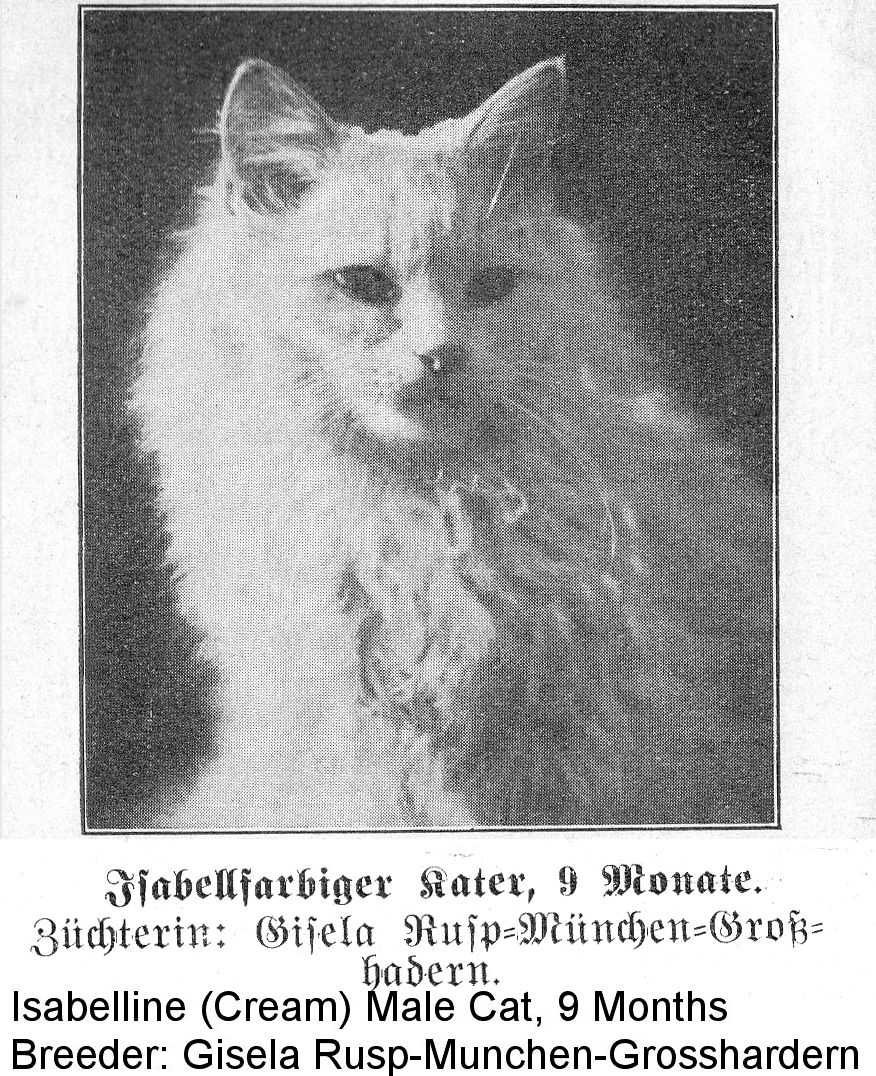
VIEWS AND BREEDING POSSIBILITIES
It is only when the nature of the cat is properly understood, and its origin has been clarified, that it is possible to gain insights into desirable and achievable breeding possibilities. No-one thinks of breeding pigeons for egg production, or thinks of producing chickens or geese to fly out into the fields and meadows, or expects to get ham when he fattens oxen.
Just as wrong, however, would be the cat breeder who tried breeding and improving cats for characteristics like dogs. Because the cat has never been properly understood it has been bred wrongly or irresponsibly and, in plain terms, it has been spoiled over the generations.
It is all about developing good, stable, fixed properties in an understandable manner. If these are properly influenced by hundreds and thousands of individuals, we can not fail to produce offspring in which the desirable qualities are inherently reliable. To what extent cats can actually be improved may be shown by some examples which the reader finds at the end.
On the whole one must always keep in mind, that we must finally give up speaking of the cat in general as though all cats were stamped from the same mould. While not all dogs are vigilant and obedient, it is equally true that cats are not all the same in terms of their good or bad properties. However, where the bad properties prevail, you have to give up the race because no naturally shy, cantankerous Tomcat Saul in the world will produce a snuggly, comfortable Paul for you.
The cat family, whose breeding has been neglected for centuries, will not change like a chameleon, but we can expect a remarkable change to take place after a few generations.
In the end, the question of cat-breeding and we can safely give the solution to the riddle - will be a question of money. On the whole, people take little notice of something which costs nothing, which is easily and effortlessly obtained, and which is sometimes not just given, but is forced on us. Until good and beautiful domestic cats are being bred, so that the breeder can hope and ask for a worthwhile prize, the matter will not get going.
Now it is not every man's thing to buy expensive pedigree cats. However, we have already shown that in the Cyprus [tabby] cats, we already have a variety of domestic cat that can be bred and that would quickly appeal to those who love beautiful, well-groomed and well-mannered specimens. There is a nice breed to be had in the shades of yellow brown to the rarer red-brown.
One should not underestimate such a breed developed for colour. There are almost unimagined possibilities. It is true to say that the famous Siamese cat was nothing but a common house-cat that has been bred for a distinct colour and which is now, of course, extraordinarily elegant. And if an Asian nation was so successful in this centuries ago, why shouldn t we also succeed?
Given time and patience,
A mulberry leaf becomes a silk dress.
OTHER BREEDING POSSIBILITIES
As already referred to the Cyprus [tabby] cat and its various colours, we can consider single-colour: pure white, deep black, yellow-brown to deep blue in all gradations. Finally, cats with certain constant "markings" would be an equally interesting area of breeding.
The well-known animal painter, Bungartz, who wrote the "Illustrated Cat Book" adorned with appealing pictures, lists the Black-headed Cat [Moor-headed Cat] among other varieties, though unfortunately he does not reveal where this was bred. It is a white cat, with a sharply delineated black head and tail. Bungartz must have encountered this variety more than once, for he says of it: Cats with good and correct markings are rarities and highly valued. He also mentions that the same markings can occur in gray, blue, or yellow, as this was quite common, in which case it goes without saying that the name "Black-headed Cat" would not really be appropriate and we would have to call these Grey-headed and Yellow-headed cats, or if one wanted to be poetic, Little Red Riding Hood Cats.
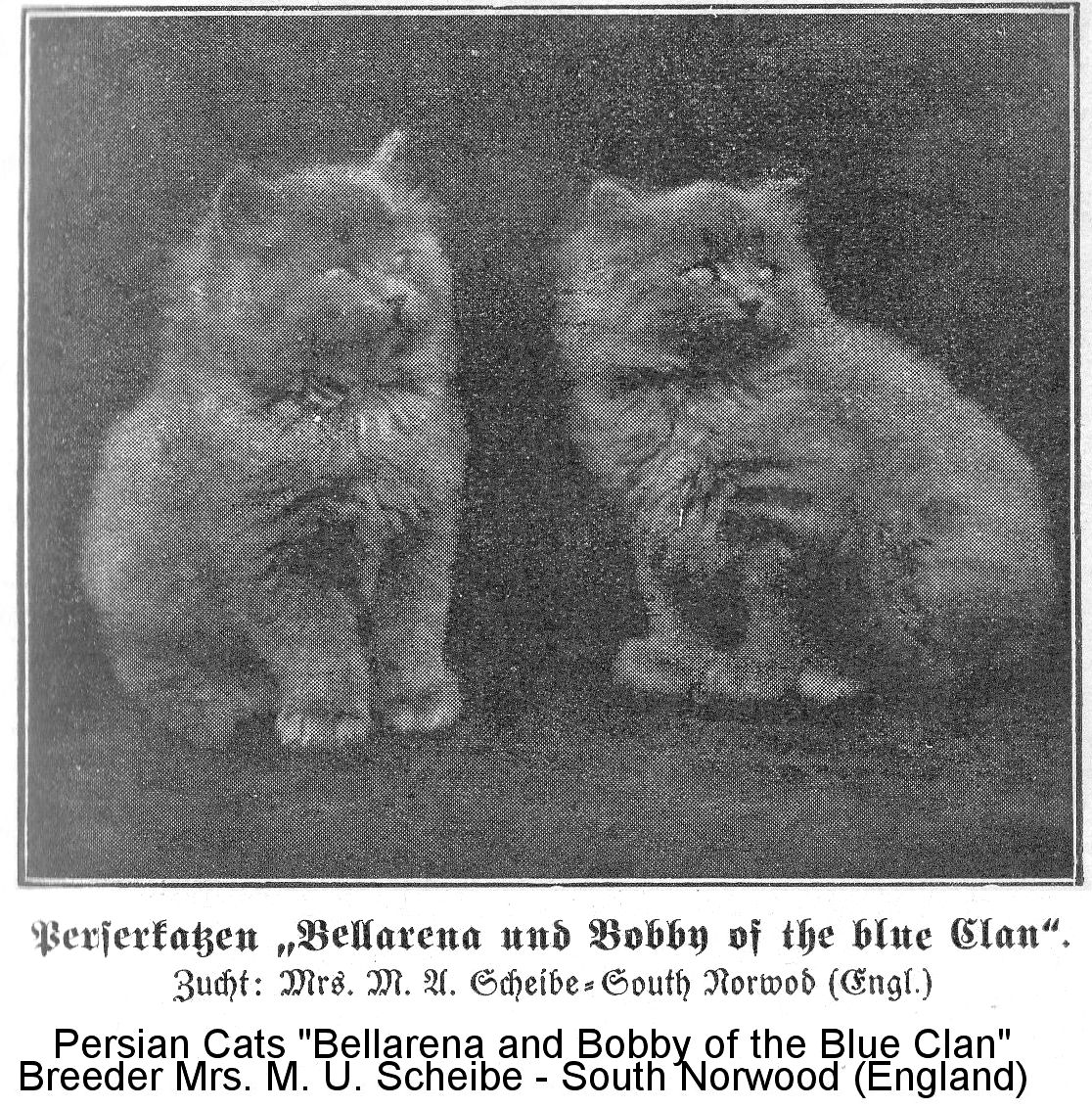
THE MASKED CAT
Even though this is less often depicted, it is by no means rare. Head and body can be any of the known cat colors, including monochrome or mackerel tabby. Only the markings are different. The head should have as regular a white blaze as possible, which may vary in width, but both eyes must be surrounded by the darker coat color. The white blaze must be wider above the lips so that the nose looks pink against the white. The whiskers must be white, which, especially in the case of otherwise black cats, is very unusual. The paws should be booted in white, and if the markings are to be quite correct, there should be longer white boots on the hind legs. A white tail-tip is not preferred, but it is not considered a fault. The throat and chest ( shirt-front ) should be white, but not the belly. Readers who have studied cat colours will already have seen these markings often. The perfectly correct markings are not often found. Naturally tabby masked cats are always three-colored. Meanwhile,
Tricolor cats are simply called Pied, which means white cats that are blotched with black and yellow-to-red-brown. Why they are also called "Spanish" cats has not been established. In addition to the three-colouredness, to still demand regularity of spot distribution, is not cheap. But if the distribution of the coloured spots still gives a uniformly beautiful picture, we scarcely need mention that the value of such a cat is high. In order to prevent misleading perceptions, it is proposed that this variety should always be in the form of Three-Colour Piebalds [tortoiseshell-and-white] and the concept of the irregular and accidental markings is also included in the depiction. It should be mentioned that in many places there is a strong opinion that these three-colored piebalds are particularly good mouse hunters.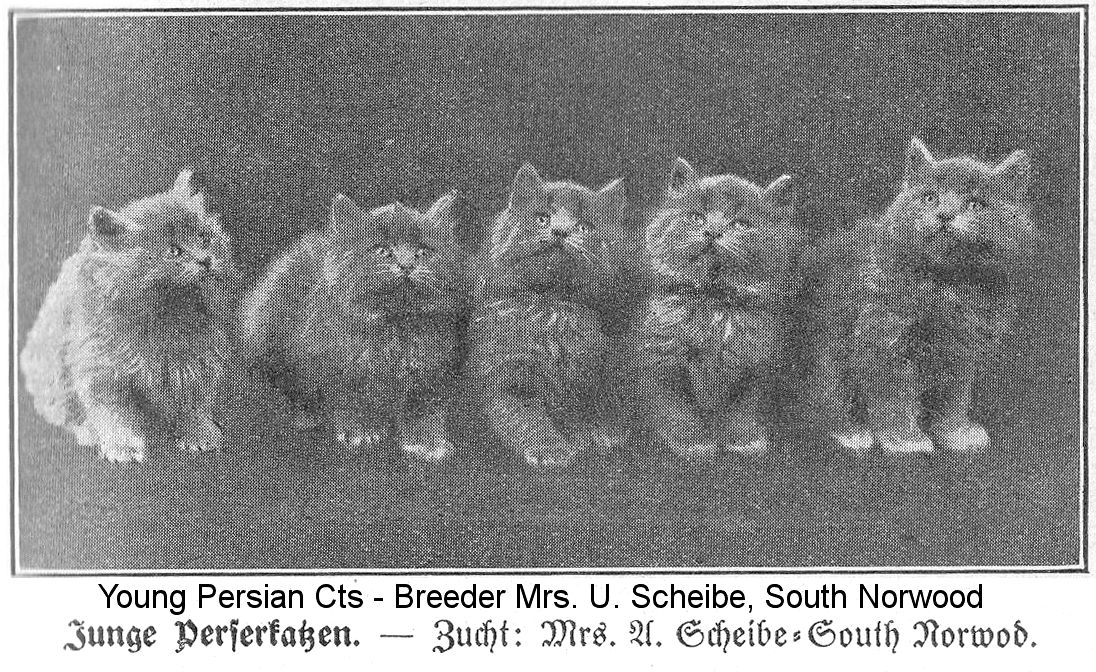
This may be a superstition of little interest, but it would be interesting, however, to finally clarify the question of whether it is true that these kinds of piebalds are never tomcats. Since this statement was made to me only quite recently, I have only been able to examine 64 cases, and it is true that these were alway female animals. Bungartz has also never seen a three-colour tomcat, for he writes: "It is said that there is no such thing," and he does not contradict that view. Now it is true that tomcats are more rare in the cat family, but not so rare, that three socre of cats can be examined without finding even a single tomcat among them. We are careful to say it is said, but all that is certain is that three-colour tomcats are rare among piebalds. When breeding certain colours there can be no reliable advice until this question has been clarified.
It is very significant we are still very much in children's shoes regarding our knowledge of cats if such questions are still unresolved.
SINGLE COLOUR CATS
When one has dealt extensively with the coat colours of cats, as we have just done, we must conclude that monochrome cats without any markings are rarely found among domestic cats. With Angora and Persian cats the case is probably different.
First of all, it is wrong to assume that all black cats are pure black or lacquer-black. In many balck cats a ginger or brownish tone can be found and, of course, this is not desirable in pure bred cats. Black cats, which should always have yellow eyes, are undoubtedly peculiar. The painter Bungartz delighted in them so much that he described them as the "most beautiful, but also the rarest variety . . . Apart from its size it looks like a black Sunda-Panther." It is very seldom that they are pure black, and regarding such pronounced value judgments, it could be argued that the prize for beauty is not so unconditionally attributed to black cats by others.
Pitch black cats, the so-called Raven Blacks and Night Blacks" were apparently viewed quite differently by our forefathers. In their superstitions, black cats accompanied ugly, old and no doubt deformed witches, haunting crossroads at night-time and terrifying solitary travellers. In their imagination, even if the Prince of Hell did not inhabit such black cats, they were generally possessed by all kinds of evil spirits of the lower ranks.
Victor v. Scheffel s fine tomcat Hiddigeigei, who is incidentally entirely philosophical and worldly, and not at all given to malice, is black-furred and Masius says, without making any value judgment, "such a black cat lies like a piece of night, from which only the green stars of eyes shine out."
Similarly, Indians see the white cat as a reflection of the moon, expelling the grey shadows of the night, that is, the mice. In German fairy tales, the princess is turned into a demure white kitten until the inevitable prince saves her. Even the delicate pink of her skin, which appears almost translucent on her ears, comes into its own, and with the often silvery glow of her fur has earned her many friends. True, white kittens are constitutionally and physically less healthy or robust than dark ones. No less an authority than Darwin has stated that pure-white cats with blue eyes are always deaf. This scholar, however, expressly limited this judgment to French, English, and Persian cats. Darwin is mistaken if he wants to include the German cat in this statement, for while it is true that deafness is often associated with blue eyes, it is by no means an invariable rule. Breeders can deduce from this the doctrine that white cats are only to be used for breeding if they have different-colored (generally yellow) eyes.
Grey, blue-grey, and ash-grey to grey-brown cats can hardly be described as beautiful, only the vivid blue-grey which is more often found in Persian and Angora cats, is also attractive.
Isabelline (cream), yellow-brown to rust-brown cats are only really attractive in the lightest and darkest tints of this colour series. Cream is also the main colour of the Royal Siamese cat s coat, and even though she is a short-haired cat, she is a most peculiar breed of cat. Perhaps this most beautiful of all cats may have been bred from a self-coloured strain, and the facts seem to indicate this, because all Siamese cats are born unmarked cream-coloured or almost white and their distinctive markings only develop later.
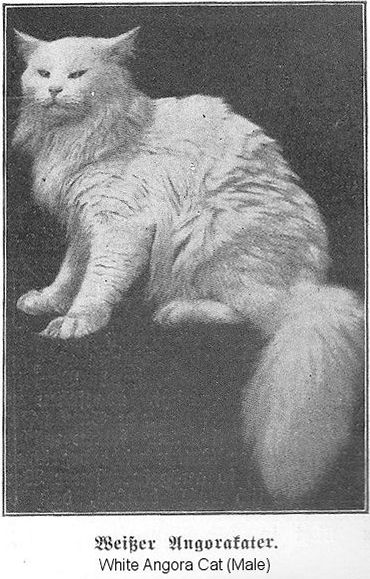
CAT BREEDS.
We start with aforementioned
Royal Siamese or Palace Cat, for the reason that it is closest to the domestic cat, in spite of its great peculiarity, and because it appears to us as a brilliant example of the fact that we are certainly not on the wrong track when we German breeders always envisage breeding coloured cats. It will easily to successfully breed beautiful cats in consistent colours, which can then also be called races, and it is probably possible to achieve a perfectly worthy companion to this strikingly peculiar cat, perhaps in silver-grey, one that is an equal to this specimen. First let us try to describe the perfect Siamese cat in words. To start with, the basic colour is isabelline or creamy yellow, one might even say with the slightest hint of red. The shading then becomes deeper fawn-colour at the neck, and on the thighs and legs until it becomes a deep sable-brown on the head and the paws. It also changes from light to very dark as it extends along the tail towards the tip and and similarly on the ears.The reader will now understand what meant when saying it would be possible for breeders to create a cat that had the same variations in tone, but ranged from the lightest blue-gray to blue-black. This would then be a variation of the Siamese cat, and would turn out to be a silver cat, while the current version has more of a gold tint.
As we said before, this is new territory for breeders and breeding. Whoever achieves this, who gets the lucky hand, might by diligent breeding take entirely different paths. One must not scold the visionary who wants to show the range of possibilities that breeders dream of. For instance, when discussing the Cyprus (tabby) cats. If there was a black variety where the tiger-markings were still visible on a charcoal background, then were would doubtlessly have a random game before us, such that by pairing a black cat with a gray striped cat, this image emerged, but is not an obvious beauty. Now the subtle tiger-shading is natural one, and undoubtedly more fittingly adapted to the splendid forms of the cat's body than the Siamese cat pattern described above. How splendidly effective those same markings would be against white!
Once again the well-disposed reader will be thinking that the author is dismissing the subject, that he is not offering instructions for breeding, and is merely making idle speculation. We would gladly give instructions, but we lack knowledge we are all learners in this field of endeavour. Our statements, imperfect as they must be at present, are honest attempts to show a path for breeders, and hopeful we shall soon be able to write a better account of what the breeding path has shown us in the way of obstacles or what new vistas have opened up.
For example, how valuable would it be to know how breeders arrived at the magnificent colour of the Siamese cat. There is no tangible information anywhere about their methods. This is also not included in "Animal Culture and Fantastic Cats," which Wally v. Oertzen (December 1925) wrote for the livestock exchange (December 1925) and from which we take the following sentences. The author writes of the "Royal Cat of Siam," which, according to cultural history, is known to have been kept exclusively in the palaces of the princes for centuries, and that the souls of the deceased lived on in these beautiful animals, and therefore anyone who harmed one was punished with death. "It was only in relatively recent times (since when, and by whom in the first place, it has not been said) that these cats have been brought out. In some cases, visiting foreign royalty have been presented with these rare animals as gifts and have brought them back from Siam." Once again it is a case of supposedly and we are given no further information, no name and no time. At any rate, we agree with Mrs v. Oertzen s pretty judgment which she made regarding the breed under consideration: "It is a strangely interesting creature. The most wonderful thing, however, are its eyes, which glow like large round turquoises from its dark face. In artificial light, they glow ruby-red, which creates an amazing effect."
There is the following observation of interest to breeders: "A particular peculiarity of this rare breed is the biologically still unexplained knot at the end of some specimens tails." The observation concludes thus: "If I look into the clear eyes of my Siamese cat, all sorts of enigmas seem to me to be hidden in them. There is melancholy and passion in the depth of those animated gemstones, and ancient oriental fairy tales come to mind."
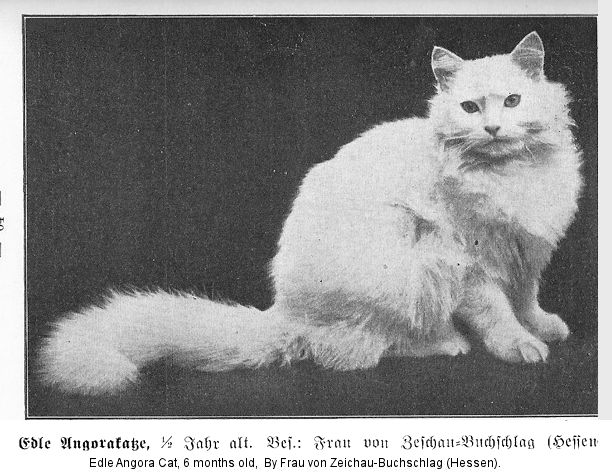
LONGHAIR CATS.
Whether these came from Angora or were bred in Persia, breeders apparently made the right decision and did not tinker with the cat s shape through selective measures, as the noble lines of their regal race are perfect, but turned their attention to the hair coat and its colouring. Thus the Angora and Persian cats probably arose at the same time as the Siamese. These admirably beautiful long-haired cats probably had geographically separate origins, but have been quite recognizably bred in the same direction.
ANGORA AND PERSIAN CATS
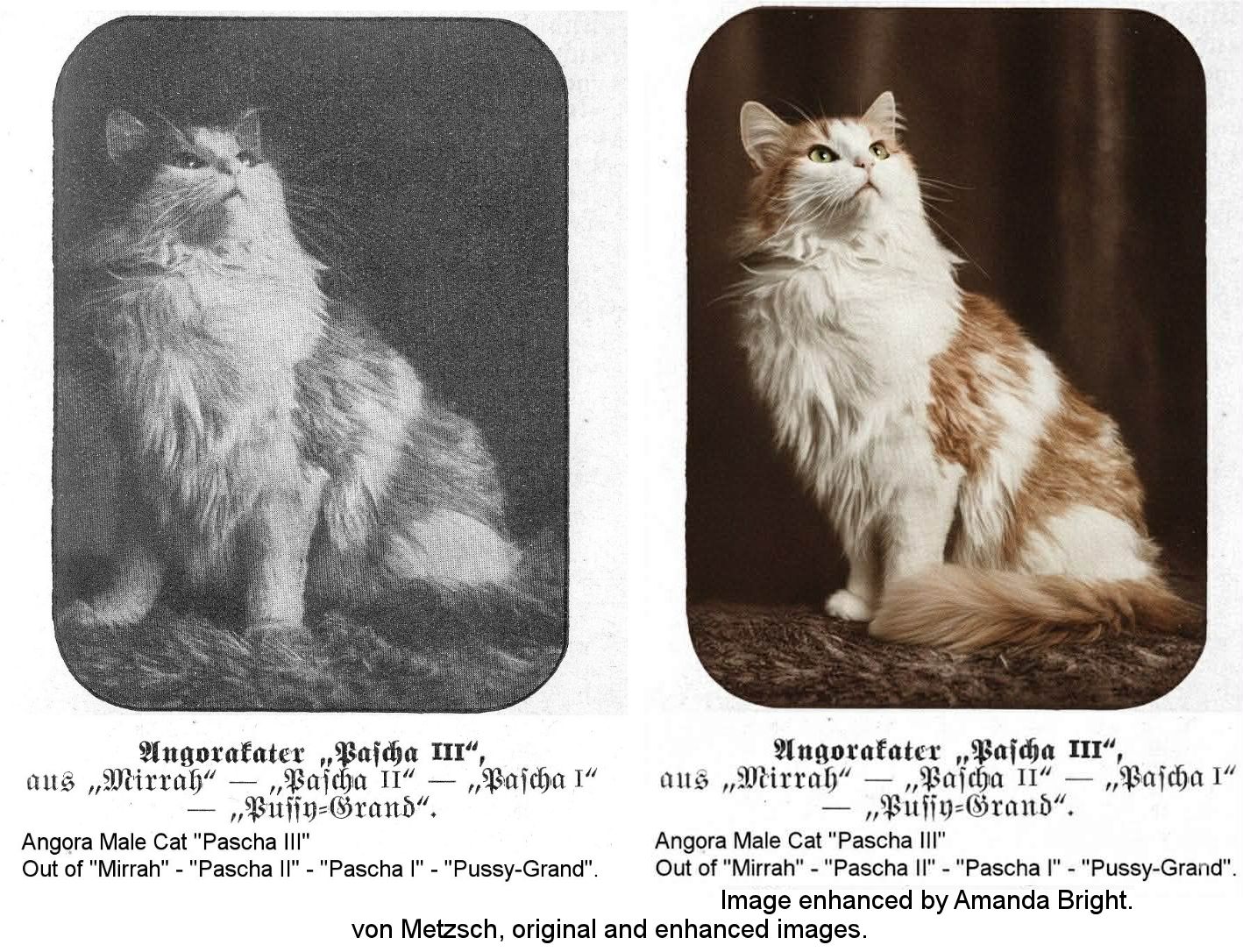
Nearly three centuries ago, around 1650, the papal chamberlain and explorer Pietro della Valle first brought cats from Chorasan (northern Persia) to Venice, from where they soon found breeding places in the then three great metropolises of Paris, London, and Vienna. Today, in the German lands of Nuremberg, its fame is due to the fact that here the beautiful foreigner found perfectly good and purposefully managed centre of breeding. Thus in November 1925 in Dresden, thanks to the warm-hearted enthusiasm of A. Silgradt, editor of the "Animal Exchange [Tier-B rse], the "Cattery and Cat Protection Association," whose breeding department is entrusted to the author, hopes to develop a valuable relationship with Nuremberg and work together. Perhaps then the pen will one day be found that summarizes all the experiences gathered from all over Germany, that the entire cat breeding issue is finally also making progress in Germany. Only then will it be possible to finally write a comprehensive guide, rather than just give guidelines, for the breeding of this pet in the widest sense.
With regard to the two long-hair breeds mentioned here, as we would like to call them, we believe that we must reserve our judgment for the time being. There is the slight danger that, by giving individual judgments, however accurate they may be, it will open the way for prejudices which could become disruptive and through up obstacles on the tried and tested and mature process. Preconceived opinions could create much mischief in the field of breeding; it is reminiscent of the tiresome question of inbreeding. While it is better to first remove the wheat from the chaff before sowing seed in the new land, we will always have cat breeding questions. One day "the cat will come out of the sack", and hopefully it will be pretty cats that will appear by and by.
Domestic cats [shorthairs], Siamese cats, Angora cats and Persian cats - these should essentially be the four luminaries that appear in cat shows at upcoming exhibitions.
In the context of long-haired cats we would also consider the following:
CARTHUSIAN CAT [CHARTREUX].
It is true that Brehm says: "We know just as little about the origin of these particularly hairy cats, as we do about other silky-haired domestic animals, to which we also like to add the 'Angora' for previously unclear reasons. In any case, this uncertainty alone must not give us cause to accept that the Angora cat can claim a special descent, for example, from the Manul.
But Brehm briefly and succinctly describes the Chartreux cat s coat with two lines. We leave it to Bungartz to describe it as follows: a self-coloured blue variety with long fine hair (Brehm says: long, soft, almost woolly), black lips and black soles to its feet. The blue colour varies from bluish ash-grey to bluish-black. The attached figure showed a cat hardly distinguishable from the Persian cat. The assumption cannot be far off that this the same thing but given a different name, just as Persian cats are also known as Khorassan cats.
The long-haired Chinese cat, whose look is spoiled by its lop-ears, is in a class of its own.
CHINESE CAT.
In Hamburg, the aforementioned animal painter purchased a stout, well-behaved creature characterized by a thick, bushy tail and half-long body hair from a sailor. Bungartz introduced it as a fattening-up breed bred solely for the purpose of serving as a roasted feast. We have no doubt that this peculiar creature exists as shown in his illustration. However we strongly doubt the story of breeding them for consumption, as we have received confirmation from various travelers to China, that they never observed such animals, as reported by Bungartz, being offered for sale in bamboo cages as rabbit substitutes. The story strongly reminds us of the "Singing Mice" sold in cages (of course not made of bamboo canes) in the same country, that are meant to be house mice, their lovely twittering being a substitute for the canary. There is no doubt that this cat breed exists, and it is understandable that we would like to exhibit it as a showpiece at an upcoming meeting, but of course the cage should carry the warning beware of imitations.
A finely pointed ear in particular gives a pretty cat's face so much intelligence, and makes it look so much friendlier than the faces of the big cats, and if it really needed ornamentation it should be, at most, extravent ear-tufts, which Darwin claims to have occasionally noticed with domestic cats.
We do not like to question the comments made in the name of Darwin, but "sometimes Father Homer also sleeps" and in Darwin s claims that white cats with blue eyes are always deaf, he is also mistaken, as we have seen.
Although we have been talking here about breeding goals, we seem to have warned breeders several times against making material changes in the cat s external appearance; on each occasion we have done this with the slight misgiving that we are expressing our own personal sense of aesthetics, which may not be fully justified.
It is a real joy to us that when speaking of lions, Brehm very emphatically comes to that same conclusion when he writes: Among the predators, the cats are truly the most perfect figures. The equal symmetry between limbs and body, the regularity and uniformity of their structure, these cannot be found among other predatory mammals. Every single part of their body is graceful and delicate, and for that very reason the whole animal greatly satisfies our sense of beauty. Without doubt, we may regard our domestic cat as the image of the entire felid family, for in no other carnivore family is the original form so rigorously repeated among all its members. And Sch tlin writes even more passionately: Everything about the cat is built uniformly, no part is too big or too small, that's why even the slightest deviation about her is so obvious. No creature s head is better shaped.
Here we list some golden words as an urgent reminder before you wish to undertake any breeding experiments to change the archetype of the cat.
As much from the point of view of animal welfare as one of aesthetics, it must seem barbaric that little more than a hundred years ago in large districts of Germany decrees were issued and strictly enforced, according to which all cats in the country had their ears cut off smooth to the head. This certainly achieved the aim that these disfigured and mutilated creatures would not set a foot out of doors in even moderate dew, as their unprotected ear canals were extremely sensitive to wind and weather.
DIFFERENT BREEDS WITH INSUFFICIENTLY ESTABLISHED CHARACTERISTICS
Those who look back on the records of alleged rabbit breeds four to five decades ago, when they began breeding this useful animal in Germany, will shake their heads with a smile today. Anyone who ventured to the light of the public with his knowledge and alleged experiences at the time appears today as if he had written for the comic papers. We do not want to expose ourselves to the same sort of criticism and here we will ditch paper wisdom that cannot stand up to later critics. There is stump tailed cat from the Irish Isle of Man.
STUMP-TAILED CAT
However, there are still very different opinions about its origins and breeding. Bungartz offers a description. This animal appears in the same patterns as the Cyprus cat. The stubby tail, as cannot be described otherwise, looks simply atrocious and their overbuilt hindquarters look even worse. This should enable them to jump powerfully and climb with great skill. However, we believe that these abilities are likely to make them particularly unpopular. If any of our domestic cat's features do not require our support, it is certainly just these two.
Incidentally, in his Letters, Brehm also of the occurrence of cats in the Lesser Sundas and Japan that had atrophied tails or ones that sloped piecemeal. Detailed research might lead to the conclusion that these are not racial characteristics but signs of degeneration, if not symptoms of disease. That in strains of cat exist in Siberia with sable-like, dense fur, is perfectly explainable from climatic influences. The same applies to a type of cat bred or found only in Iceland. The author visited Siberia four times and in addition to particularly hairy cats also found horses that literally had bearskin fur. However it never occurred to him that these were specific racial traits.
Let s not be tempted to go down the slippery slope of describing races whose characteristics are by no means fixed, or which, if God sees them as defects, are nothing but random occurrences. We can only advise everyone to try to preserve the domestic cat breed, or depending on taste and means to turn to the development of the well-known breeds, and to keep to already fairly well-traveled paths and not to blunder about in the dark.

In America there are cat farms. I have talked to Americans a lot, but none had seen a cat farm. But there are cat farms in America, and so it is high time that we set up cat farms in Germany at once. Why not, we have it! The money is missing front and back, but for cat farms it just has to be made "liquid." We are completely missing experience in this area completely, but we can gain experience - but only have cat farms. A secure market for large quantities of valuable cats does not yet exist, but that can be found: If first in Germany, the cat farms shoot like mushrooms from the ground, they can buy their stock one from another and then the business is sure to flow as is the money.
These are not the thoughts of the author, he just listened to the words of the wise old mouse at noon. And no-one in mouse circles is actually afraid of cat farms. At first they would think they were only institutions where cats were fed and bred in bulk, in which one would have to "pull the fur over the ears," in order to use it, and would believe that such cat-skins would cost the producers dearly.
[Note: "pulling the fur over the ears" is a method of skinning an animal, aften while alive, so that the fur is not damaged.]
On the other hand, thanks to very good connections in rodent circles, I am able to report that there is great consternation that the promotion of associations for cat breeding and cat protection emanating from the "Animal Exchange" in Dresden, is gaining ground. As long as only the breeding of Siamese, Angora, Persian and other high-bred exotic salon cats is promoted, there are no great concerns amongthe rodents. After all, it will not happen that quickly. It's quite a costly pleasure, and of course, mouse circles do not take Angoras very seriously. According to my seasoned old rodent, the haul that that can be sang of by an Angora only embarrasses the guild. A righteous old greyback need not fear the hunting skills of that breed!
If, of course, domestic cats were to be bred in beautiful varieties of colour, and the spread and care of the domestic cat were greatly promoted, hundreds of breeders would emerge, who would then move from small to large - not the other way around - and the growing interest would naturally lead to increased demand, in which case even greyest mice would blanch in fright. Stud cats should also be procured, possibly free of charge and carriage-paid, and that will bit you, little mousie!
But cat farms involve money, and who in Germany still has money!
I allowed myself the shy objection, what do mice circles know about our finances? But then I came to a nicety! Ironically, we should not know this, we who have gnawed so many devalued inflation certificates, we who know all the storerooms inside and out! Where once whole rows of sides of bacon and sausages hung, barely a quarter of a dozen now dangle from the ceiling. There were no St. Martin s Day goose at the Lehmanns, who never stinted otherwise, and Knietschkes had but three stollen cakes at Christmas, and with "Blauband" into the bargain [i.e. with margarine because they could not afford butter] , and even the Raffkes are looking at cutting down.
If you do not want to start off in a big way with a cat farm at once - the opinion prevailing in mouse circles being that they know a lot about your means - but you nevertheless want to breed confidently, you must, once you have made your choice, remember to set up some sort of breeding cage. You cannot properly guarantee the mating business in any other way and the mother will need the cage as a place to give birth and to take good care of her little ones during their first critical weeks. Cost: a few marks.
We cannot agree with the cage recommended by Bungartz. At 1.5 metres in height and depth, and two metres in width it is sufficient to hold one cat. Moreover, our breeding cage simply takes the form of a correspondingly large box, with a wide-meshed wire net on the front. On the right and left are small lockable swing doors. In the background, to the left of the viewer, a box 1 metre long and 50 centimetres in height is attached. This box serves as the birthing chamber. So that you can look inside, it must be set up so that the lid has hinges and is foldable. The door in the left-hand side of the main box must be quite large, higher than it is wide, so that one can look inside, while the door on the opposite side is low and shallow. Its sole purpose is to allow the breeder to push a soil- or peat-filled tray in which the mother cat can answer the call of nature. The faeces produced by the infant cats are usually removed by their mother at once, apparently by consuming them with a great deal of appetite. In the middle of the breeding box described above, it is easy to install a small ladder with a thin cross-piece for climbing and the bower is then ready for use. We surely need not mention that the box attached to the left rear must have a small pop-hole for the mother cat and her children, but one will be enough. We are told that the painter, Barett, had two cats, one big and one small, so he had a large and a small pop-hole put in the door of his studio. "Wouldn t a single opening have been enough?" asked a visitor. "How could the big cat get through the little hole?" replied the artist, "Well, couldn t the little cat get through the big hole? You re right," cried the astonished Barett, "she certainly could, but I didn t think of that!"
Wherever the cat s breeding plans are not questioned, which has been the rule so far, cats mate to the accompaniment of the well-known concert that began thousands of years ago in the heart of Africa and would not have happened any other way among their wild or half-tamed African Wildcat ancestors. Only the scenery of the steppe was different, but the moon surely saw the same cat fights, surely heard the same background music.
Somewhere I read the following verses:
While the rabbit reproduces gently,
The lion is almost murderous,
Beating the agitated lioness s
Flanks with his paws.
Here, too, the cat betrays its origin, its closeness to nature, and this is why it is such an interesting creature for the thinker, the observer, because unlike other pets they are not pressed out like leather books and they never will be pressed out that way. A female cat that is presented to a tomcat must be at least one year old, and the tomcat should preferably be a little older, one and a half, or better, two years old; the question of how many female cats can be expected by a tomcat is, therefore, probably not easy to answer because certainly there is still a lack of reliable observations and certainly the age and condition of the cat are crucial. Nature gives us indications that just two dozen or more different queens may mate with a tomcat. For a start, there are far more female than male cats, and secondly, the tomcat does not take any care of the kittens. In fact there are occasionally cases where he has eaten them in their first few days, which explains why the mother cats usually, if possible, give birth to their young in hiding-places and only bringthem out into the world when they start to become self-reliant.
On the 56th day after the mating, usually in February or, the second time, in July, the young are born. But they do not see the light of the world until about ten days later, when their eyes "open". Young mothers seldom produce more than two or three, older mothers may produce twice that number. The early, generally preferred birthing time is in April or May, the late birthing season in August or September is less desirable because it results in so-called "Stubble-Cats," which lacked sun during childhood.
With these birthing times we have the answer to the child s riddle of how can a cat tell you when it was born? Easy, just pinch her tail and she will say "May". Orientals, who like to associate living beings with heavenly constellation in their image-rich language, believe that a cat gives birth to a total of 28 offspring in her lifetime because the lunar year is divided into 28-day periods. After all, there are many indications that 28 may well be the approximate number of offspring that a cat can bear. Assuming that a breeding male produces a dozen cats, it is theoretically possible that, if he were used for five years, he would be responsible for about a quarter of a thousand descendants even if you rounded the figure down considerably. These are number games of course, because there is no completely reliable information available. The figures will probably be different and lower in pedigree cats than in ordinary housecats.
In the first three days you should, where it is inevitable, remove the kittens, preferably unobserved, that you do not wish her to rear. It is better to leave the mother to raise two, at the very least, for humane and health reasons.
The image of the cat as a loving, caring mother, and later as an educator of her clumsy kittens, is one of the most beautiful images in animal life, as her gentleness with them is as natural as her savagery as a huntress. The tigress and the lioness, and in short all the savage predator cats, are also as loving and caring as mothers. The maternal instinct of the cat and its larger relatives in zoos is often so strong that they will catch and raise young animals of different species, for example young rabbits, leverets, squirrels, puppies and, it is claimed, even young rats.
Immediately upon weaning, the kittens start to take suitable solid food. But for the first six months, they also need boiled cow's milk, always diluted with water, to strengthen themselves. Breeders of beautiful high-bred cats especially must take care to help the young animals grow early and reliably. It does not take much effort! As a rule the kittens are soon out of the woods if their mother is well-fed and provides them with plenty of milk, and infant mortality is certainly no greater in cats than in dogs.

CONSTRUCTION OF A CAT FARM
To some extent, in the purely urban household, let us say in a "flat", even in one with use of the garden", it is not possible to carry out any small animal breeding, least of all to breed cats. Certainly it would be possible to keep a stud cat, or to rear a litter of kittens, but anything beyond that would cause inconvenience, even be intolerable, and in addition, the animals kept in that way would not prosper.
The installation of an upstanding cat farm requires at least a medium sized garden plot where the owner or tenant has sole use. Here, there may already be existing outbuildings, such as kennels. Such a farm requers light, air, and sun in not too homeopathic [tiny] doses. Undoubtedly, the animals will thrive in conditions where they have freedom to roam and climb while remaining confined within the cat farm boundaries.
However cosy the cats are, their first mating season falls in one of the coldest months, February, which, according to meteorological observations, is the second coldest and often the snowiest month of the year.
It can easily be ascertained that nocturnal excursions undertaken at this time do not do any harm, not even in otherwise very spoiled "parlour cats." Also the experiences in Hagenbeck's animal park in Stellingen near Hamburg, which has quite a severe climate, teaches us that even tropical animals like to go on quite wintry excursions in the open air and that they thrive better than they would if confined to closed winter housing. Of course, draught-free heated rooms must naturally be available to the animals after their excursions.
Although larger scale, purposeful cat breeding is no longer in its infancy, the concept is still only about to get dressed so to speak, we hear voices speaking of "freedom breeding," and experiences with Angoras have shown that their fur was better and denser. There is a strong case for considering these observations to be accurate. The extent to which Siamese cats are immune to the effects of the weather in our latitudes, and how this influences their health, naturally requires a very cautious trial.
It is unnecessary to repeat here that it would be highly desirable, according to the breeding goals which we would like to see followed, to not only breed races of pedigree cats, but also to breed particular colour strains of domestic cats. The fact that such breeding, in view of the far smaller, almost insignificant price of the breeding material, would produce animals that could be delivered at correspondingly lower prices, should be pleasant for the breeder. After all, it would be tempting for quite a few breeders to gain experience in less costly ways than to start with a larger number of high quality pedigree cats right away.
All this should be considered only very general information. In fact, very experienced cat owners have found that a lot of healthy cats, when suddenly exposed to various changes in circumstance, quickly die of homesickness. It is advisable to mention this here because this says a lot for a cat farm establishment. Cats that have not grown up in any particular setting, such as a living room, will undoubtedly be spared from such influences. This may be a good reason to prefer farm-bred cats over those bred in any other setting. Many purchasers will more readily decide to buy an animal - especially an older one - from a farm than to buy it out of private hands, because then cats that have grown up in a kennel, though sympathetically maintained, are never as spoiled as is often the case with those raised in related domesticity. It is still a long way from the crucial question of whether we believe those who claim a cat is "better in her new environment." It depends on whether the cat is of the same opinion. In human judgment, the cat who grew up in a cat farm gets a much better life at the home of the mayor in the city, but the cat herself might feel miserable despite silk cushions and porcelain china ware. The threshing floor was perhaps a hundred times better than the city parquet and the cowshed perfume more to her taste than "Eau de Mille Fleurs".
We would now like to touch on the rather delicate topic of whether any thought should be given to breeding and farming cats for fur production. To those who read these considerations, it is needless to say that the author would not want to own such a farm, wher he would have to look at his stock each day to see whether it is time to pull its coat over its ears [skin it].
But let's put sentimentality aside and make some calculations. A cat's coat costs between 2 and Marks. Of course, the "producer" won t even get 3 Marks. Consider a 3 Mark coat means 300 pfennigs for the skin of an animal which must be 600 days old in order to deliver a complete coat. What sort of fool do you take for? It costs 0.5 pfennig per day to feed and care for a cat, get a thaler (silver coin) from me and he can keep the coat.
The ridiculously low number of cat skins that actually go on sale are certainly of very dark origin. Those cat skins are exactly like the twig brooms that a hawker offered for 30 pfennig. A competitor sold the same brooms for 25 pfennig, but he was known to have stolen the twigs. "Good grief, I'm stealing the twigs, too, but how that guy makes brooms for 25 pfennig is a mystery to me."
The same thing no doubt happens with cat skins too. So we do not want to breed them for skins, but we probably want to breed them with beautiful coats as we progress along our path. The Orientals had nothing else in mind when they created their Siamese and Angoras. The saying clothes maketh man also applies to the cat tribe.
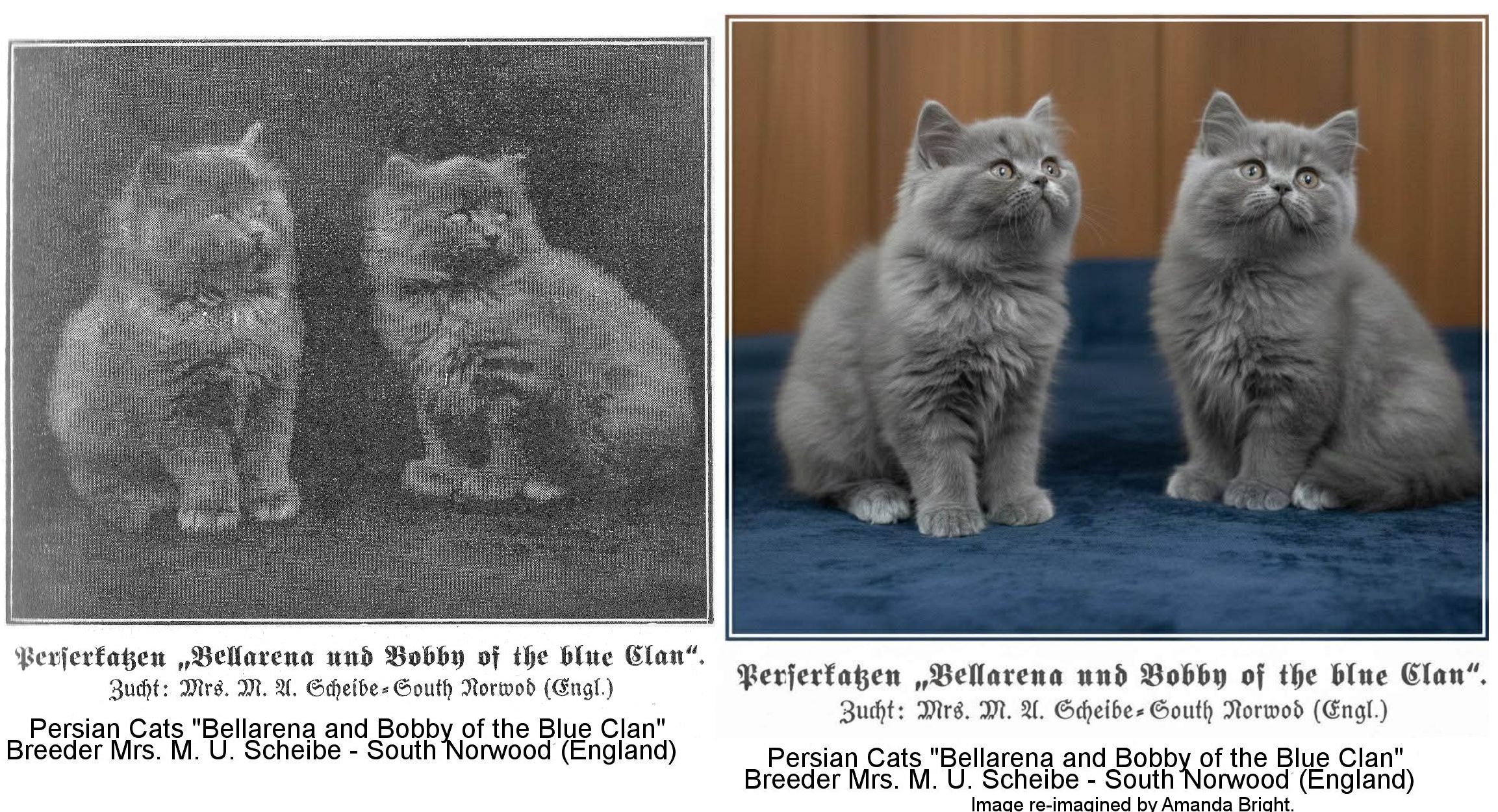
USEFULNESS OF THE CAT
The naturalist Lenz has proved that a cat in a rural household can easily satisfy her need for meat by hunting mice, with such precise observations that we will reproduce his own words here:
Lenz says, "It is astonishing what a cat can do in the extermination of the rats and mice, and to give an idea of numbers I will give the results of Lenz's investigations and observations: To know how much a cat does in the way of exterminating mice I have used the mouse plague year of 1857. I locked two light-yellow, tiger-striped half-Angora cats, aged 48 days, into a small stable furnished for such trials, giving them milk and bread every day, as well as 4 - 10 mice, which they devoured each time. When they were 56 days old, I gave them only milk and 14 adult or half-grown mice. The kittens ate everything, threw up none of them, were in excellent condition, and had their usual appetite the following day.
Shortly thereafter, when these known mice-eaters were released, I locked a tortoiseshell 5 1/2 month-old half-Angora cat in the same stable at 9 pm, and gave it no food for the night. The animal was miserable at being imprisoned and separated from its childhood playmates. The next morning I gave it a mixture of half milk half-water for its daily ration. I had a supply of 40 field mice and gave it a number of these at intervals. When, in the evening, the clock struck 9 p.m., that is, after 24 hours of imprisonment, it had eaten 22 mice, of which 11 were adult and 11 were half-grown. It did not throw up and was very well.
That year my cats were busy catching and eating mice, but on the 27th of September, each of them ate 8 mice in the time of 1/2 hour, from which I extrapolated some figures.... After such experiences, I can assume that in mouse plague years, cats that are half-grown consume a daily average of 20 mice, thus throughout the year they consume 7,300 mice. In average mouse years, I estimate they consume 3,650 mice or an equivalent amount of rats.
Considering that on average a normal city cat can barely catch a little mouse every day, this is a twentieth of the amount of mice that Lenz's fed to cats in his experiments and a tenth of what he regards as a normal ration. In the case of the wildcat, in one case Tschudi found the remains of 26 mice in the stomach of one animal. Certainly it is clear from these reports, as also noted by Lenz, that "mice give very little nutrition."
From this we conclude that from a young age, cats naturally want to eat meat; it does not matter to mice whether they eat buns or substitute oatmeal for their food. Not until I have two siblings presented to me, one of which was purely vegetarian, the other fed primarily on meat, and I can convince myself that both are equally well developed, will I believe in the usefulness of the vegetable diet. I would be extremely broad-minded if I assumed that the vegetarian had kicked the habit, or at least never touched a mouse, never eaten a sausage lump behind closed doors, or had abstained from every sparrow as thought it were walking around hot porridge. I agree with Horace [Roman lyric poet] that you can drive nature out with a pitchfork, but it always comes back.
We politely ask the cat's enemy to look at the calculations. Let us suppose that a city cat hunted only a tenth of Lenz's average haul of 3650 prey items. Of course, 365 is ridiculously little.
It is certainly not acceptable for a fieldmouse to three pennies worth of damage per day. In a city mouse, which attacks high-quality things, does small-scale damage in proportion to its lifetime. Nonetheless it does 10 marks worth of damage per year per mouse. And even if the cat killed only two mice per week, that is, 100 a year, wouldn t this be worth the stately sum of 1,000 marks? Perhaps such a mathematical model, rather than wordy speeches to which fanatics close their ears, will enlighten even the less gifted of cat enemies and demonstrate that the cat is beneficial to us.
We want to, and will, breed the cat to be a completely beautiful and valuable animal, and we desire that it enjoy the protection guaranteed to our possession by our imperial constitution.
FEDERATION FOR CAT BREEDING AND CAT PROTECTION
OFFICE: DRESDEN-A., MOSCZINSKY STREET 2 A.
The organization for all German cat lovers and cat breeders with local groups in all big cities.
The Federation aims to promote the breeding of house- and pedigree cats of all kinds and rasie them to be more attached to man and house. It puts the cat under its protection and is helping to develop a modern animal welfare law.
Education about the cat, its nature, breeding, care and conduct will be spread through scientific and entertaining essays in the Federation s weekly publication, as well as through lectures. The Breeding Office gives advice and help in all questions about breeding. It also organizes exhibitions. The Federation maintains its own stud book for all domestic and purebred cats. It has a breeding, legal, welfare and literary committee.
Every cat lover and cat breeder must support the aspirations of the Federation by joining it and participating in all its work. Anyone can join. The monthly membership fee is only 70 Pfg. In large cities the Federation has its own veterinarians and equipment, and for a monthly subscription of Mk. 1.20, domestic animals will be treated free of charge. Interested parties can receive the society charter and registration from free of cost. The establishment of local groups everywhere is supported or initiated by the Federation. Any true animal lover must not delay, support our hopes and ideals and join the Federation!
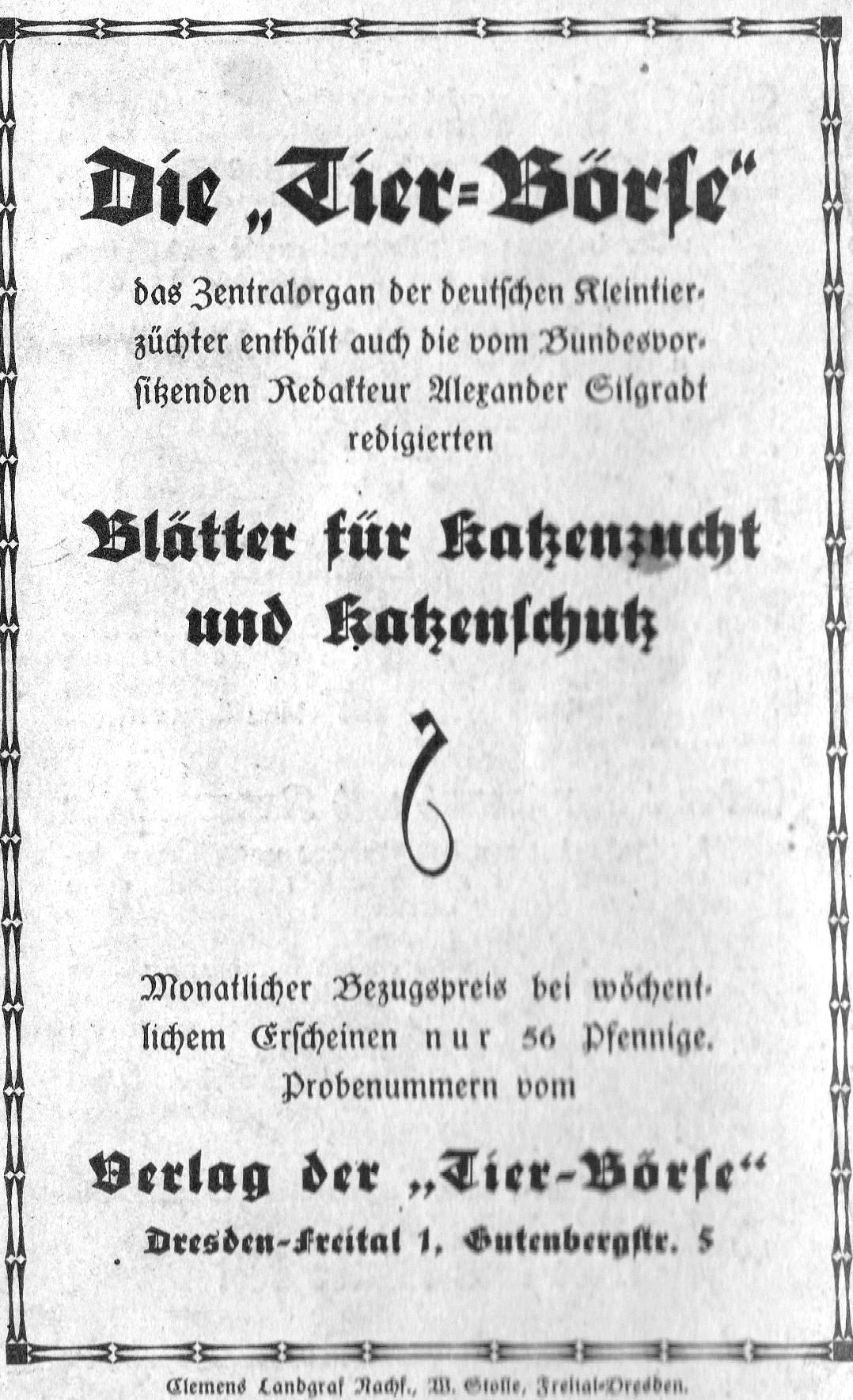
Translator's Footnote:
In my edition of The Book of the Cat the author expressed hopes of the Dresden club co-operating with the other cat club in Nuremberg. In the Autumn 1926 edition, he wrote that in his experience co-operation with the club in Nuremberg was impossible and he lamented the typical German eccentricities. The Nuremberg Club's attitude towards Shorthair cats was quite different from the Dresden Club s attitude and they considered that only the Persian-type cats were valuable enough to be worth breeding. The Dresden club was supported by Schwangart who was a known opponent of Magerl who was affiliated to the Nuremberg club. Magerl was the author of a book called Angora Cats. The Nuremberg club went on to become the German Fife member (DEKZV) and the continued mutual enmity between Magerl and Schwangart was one of the reasons that the German Longhair had no chance of being recognized by the DEKZV during the 1960s. Even now there are two opposing version of longhaired German Cats, the German Longhair and the German Angora.